Practice Based Public Health and Health Promotion Project
VerifiedAdded on 2023/01/23
|29
|10286
|28
AI Summary
This project focuses on tackling Attention Deficit Hyperactive Disorder (ADHD) in Black Minority Ethnic (BME) children aged 5 to 11 years in Bexley Borough. It discusses the causes, interventions, and strategies to reduce health inequalities. The aim is to promote good health and well-being in the target population.
Contribute Materials
Your contribution can guide someone’s learning journey. Share your
documents today.
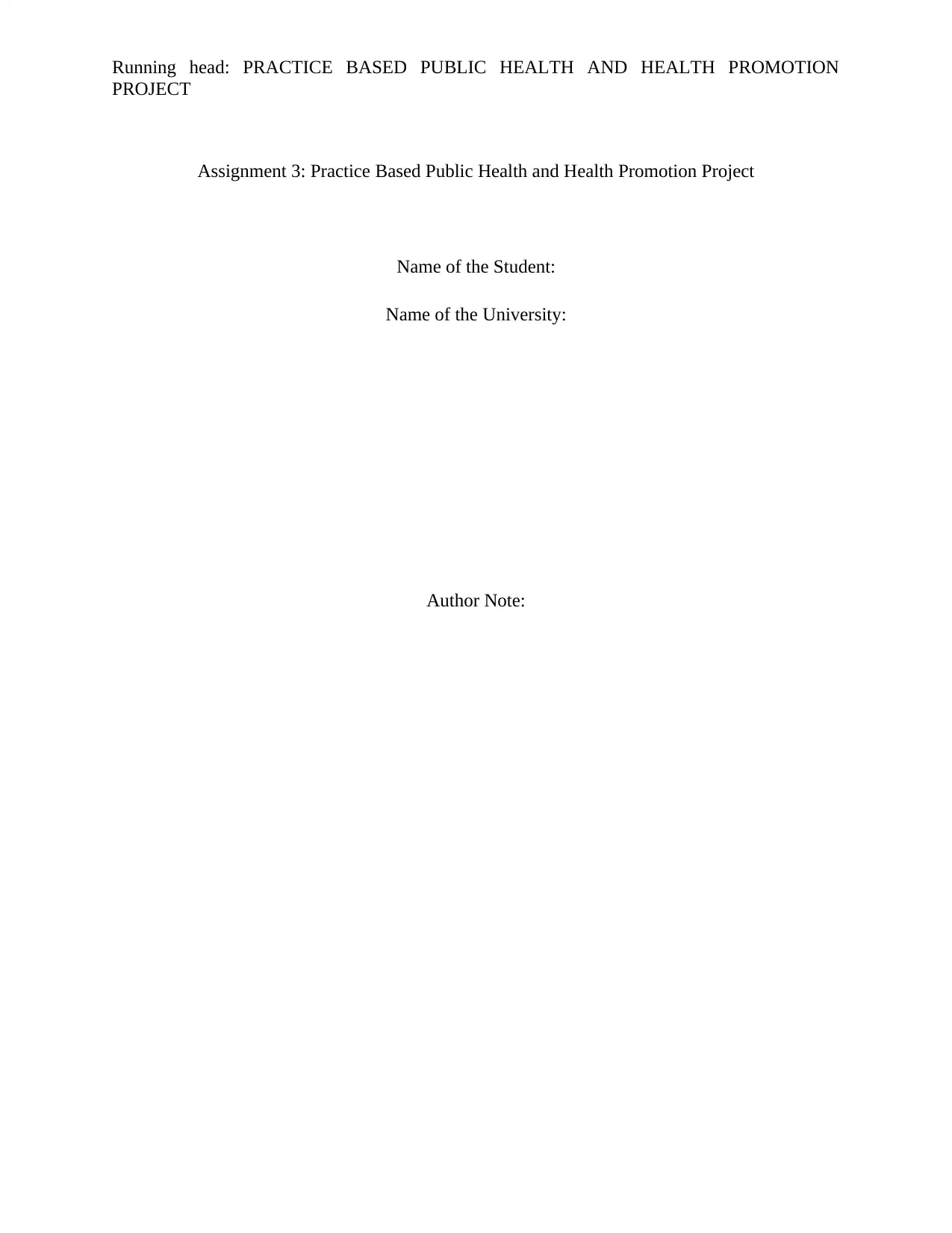
Running head: PRACTICE BASED PUBLIC HEALTH AND HEALTH PROMOTION
PROJECT
Assignment 3: Practice Based Public Health and Health Promotion Project
Name of the Student:
Name of the University:
Author Note:
PROJECT
Assignment 3: Practice Based Public Health and Health Promotion Project
Name of the Student:
Name of the University:
Author Note:
Secure Best Marks with AI Grader
Need help grading? Try our AI Grader for instant feedback on your assignments.
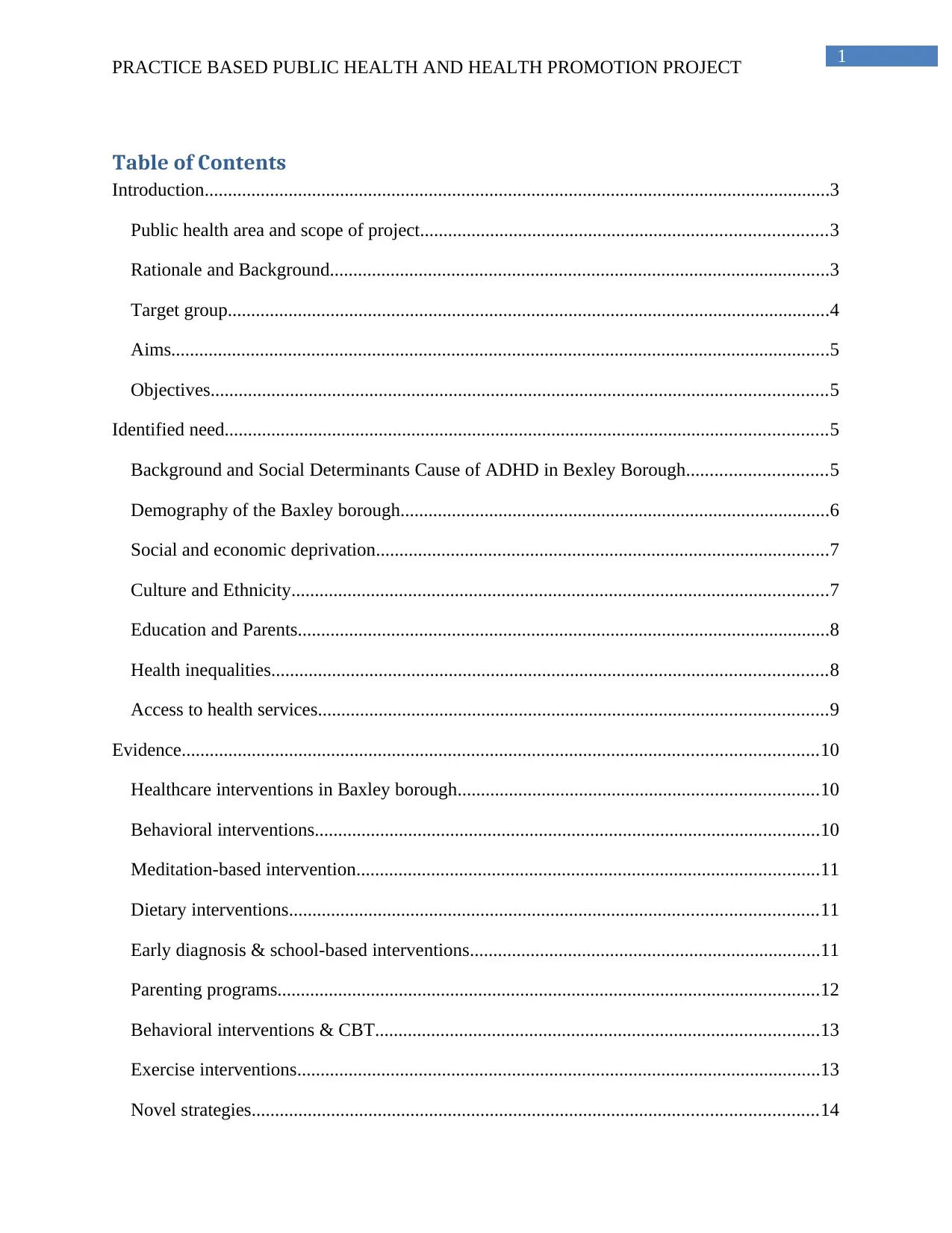
1
PRACTICE BASED PUBLIC HEALTH AND HEALTH PROMOTION PROJECT
Table of Contents
Introduction......................................................................................................................................3
Public health area and scope of project.......................................................................................3
Rationale and Background...........................................................................................................3
Target group.................................................................................................................................4
Aims.............................................................................................................................................5
Objectives....................................................................................................................................5
Identified need.................................................................................................................................5
Background and Social Determinants Cause of ADHD in Bexley Borough..............................5
Demography of the Baxley borough............................................................................................6
Social and economic deprivation.................................................................................................7
Culture and Ethnicity...................................................................................................................7
Education and Parents..................................................................................................................8
Health inequalities.......................................................................................................................8
Access to health services.............................................................................................................9
Evidence........................................................................................................................................10
Healthcare interventions in Baxley borough.............................................................................10
Behavioral interventions............................................................................................................10
Meditation-based intervention...................................................................................................11
Dietary interventions.................................................................................................................11
Early diagnosis & school-based interventions...........................................................................11
Parenting programs....................................................................................................................12
Behavioral interventions & CBT...............................................................................................13
Exercise interventions................................................................................................................13
Novel strategies.........................................................................................................................14
PRACTICE BASED PUBLIC HEALTH AND HEALTH PROMOTION PROJECT
Table of Contents
Introduction......................................................................................................................................3
Public health area and scope of project.......................................................................................3
Rationale and Background...........................................................................................................3
Target group.................................................................................................................................4
Aims.............................................................................................................................................5
Objectives....................................................................................................................................5
Identified need.................................................................................................................................5
Background and Social Determinants Cause of ADHD in Bexley Borough..............................5
Demography of the Baxley borough............................................................................................6
Social and economic deprivation.................................................................................................7
Culture and Ethnicity...................................................................................................................7
Education and Parents..................................................................................................................8
Health inequalities.......................................................................................................................8
Access to health services.............................................................................................................9
Evidence........................................................................................................................................10
Healthcare interventions in Baxley borough.............................................................................10
Behavioral interventions............................................................................................................10
Meditation-based intervention...................................................................................................11
Dietary interventions.................................................................................................................11
Early diagnosis & school-based interventions...........................................................................11
Parenting programs....................................................................................................................12
Behavioral interventions & CBT...............................................................................................13
Exercise interventions................................................................................................................13
Novel strategies.........................................................................................................................14
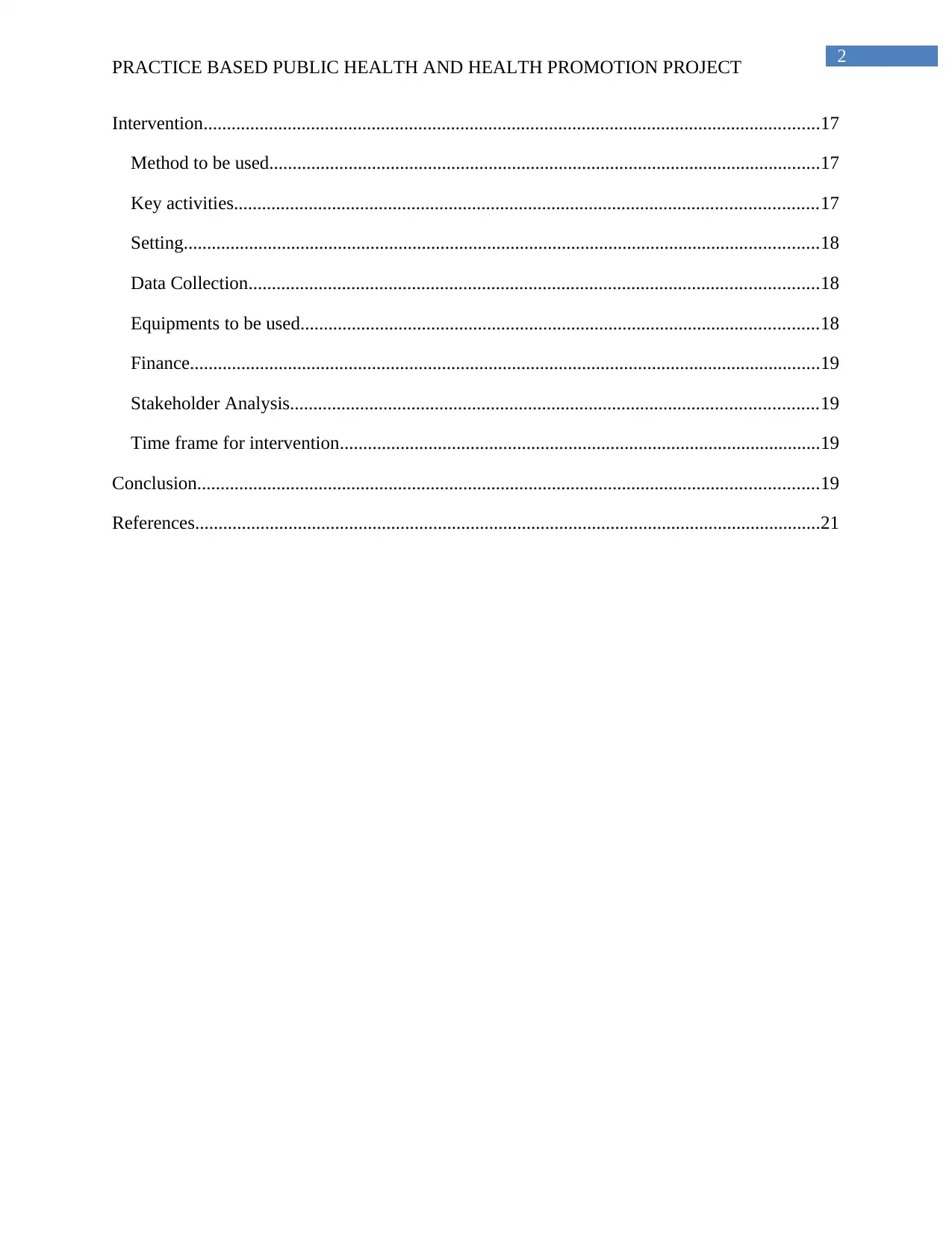
2
PRACTICE BASED PUBLIC HEALTH AND HEALTH PROMOTION PROJECT
Intervention....................................................................................................................................17
Method to be used......................................................................................................................17
Key activities.............................................................................................................................17
Setting........................................................................................................................................18
Data Collection..........................................................................................................................18
Equipments to be used...............................................................................................................18
Finance.......................................................................................................................................19
Stakeholder Analysis.................................................................................................................19
Time frame for intervention.......................................................................................................19
Conclusion.....................................................................................................................................19
References......................................................................................................................................21
PRACTICE BASED PUBLIC HEALTH AND HEALTH PROMOTION PROJECT
Intervention....................................................................................................................................17
Method to be used......................................................................................................................17
Key activities.............................................................................................................................17
Setting........................................................................................................................................18
Data Collection..........................................................................................................................18
Equipments to be used...............................................................................................................18
Finance.......................................................................................................................................19
Stakeholder Analysis.................................................................................................................19
Time frame for intervention.......................................................................................................19
Conclusion.....................................................................................................................................19
References......................................................................................................................................21
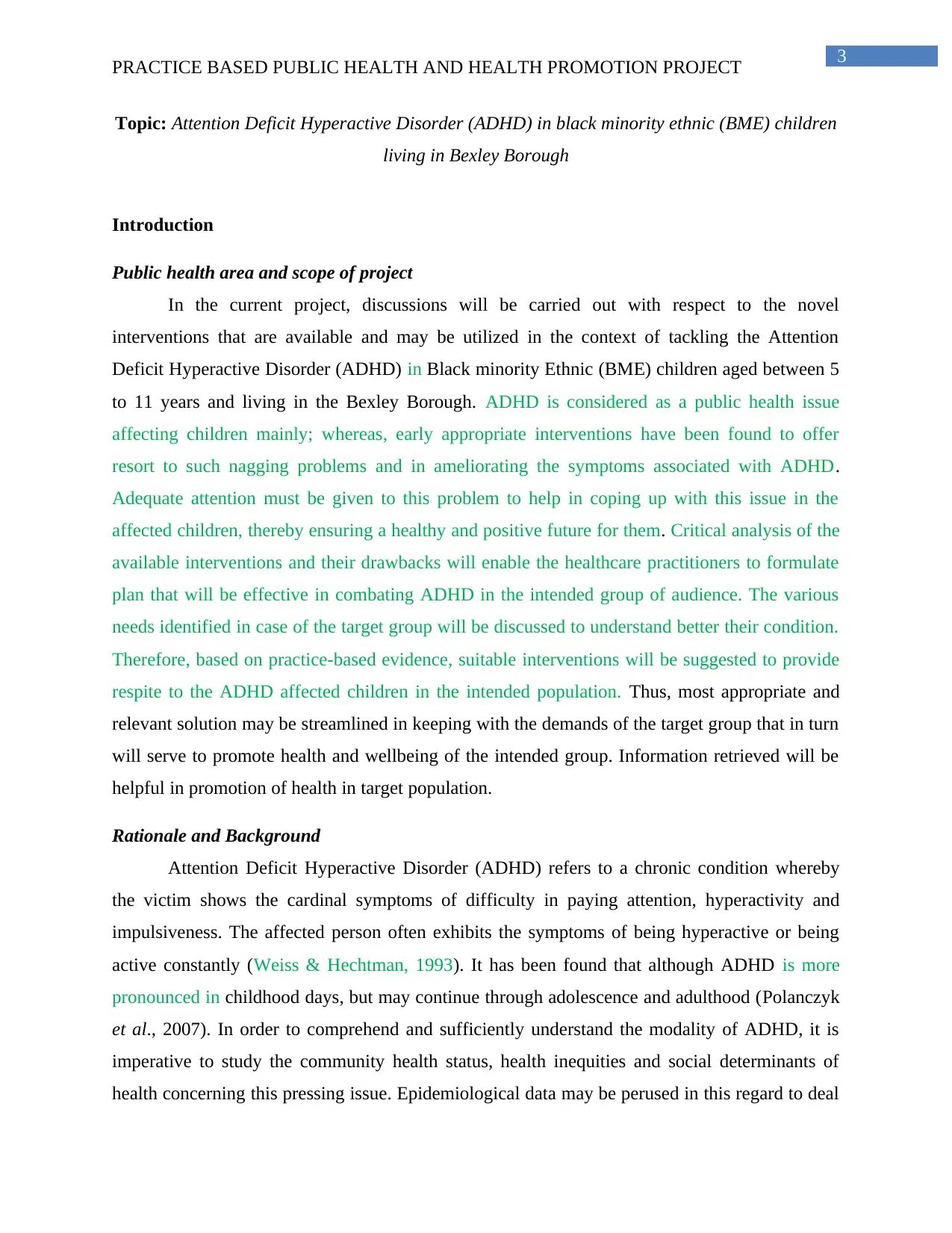
3
PRACTICE BASED PUBLIC HEALTH AND HEALTH PROMOTION PROJECT
Topic: Attention Deficit Hyperactive Disorder (ADHD) in black minority ethnic (BME) children
living in Bexley Borough
Introduction
Public health area and scope of project
In the current project, discussions will be carried out with respect to the novel
interventions that are available and may be utilized in the context of tackling the Attention
Deficit Hyperactive Disorder (ADHD) in Black minority Ethnic (BME) children aged between 5
to 11 years and living in the Bexley Borough. ADHD is considered as a public health issue
affecting children mainly; whereas, early appropriate interventions have been found to offer
resort to such nagging problems and in ameliorating the symptoms associated with ADHD.
Adequate attention must be given to this problem to help in coping up with this issue in the
affected children, thereby ensuring a healthy and positive future for them. Critical analysis of the
available interventions and their drawbacks will enable the healthcare practitioners to formulate
plan that will be effective in combating ADHD in the intended group of audience. The various
needs identified in case of the target group will be discussed to understand better their condition.
Therefore, based on practice-based evidence, suitable interventions will be suggested to provide
respite to the ADHD affected children in the intended population. Thus, most appropriate and
relevant solution may be streamlined in keeping with the demands of the target group that in turn
will serve to promote health and wellbeing of the intended group. Information retrieved will be
helpful in promotion of health in target population.
Rationale and Background
Attention Deficit Hyperactive Disorder (ADHD) refers to a chronic condition whereby
the victim shows the cardinal symptoms of difficulty in paying attention, hyperactivity and
impulsiveness. The affected person often exhibits the symptoms of being hyperactive or being
active constantly (Weiss & Hechtman, 1993). It has been found that although ADHD is more
pronounced in childhood days, but may continue through adolescence and adulthood (Polanczyk
et al., 2007). In order to comprehend and sufficiently understand the modality of ADHD, it is
imperative to study the community health status, health inequities and social determinants of
health concerning this pressing issue. Epidemiological data may be perused in this regard to deal
PRACTICE BASED PUBLIC HEALTH AND HEALTH PROMOTION PROJECT
Topic: Attention Deficit Hyperactive Disorder (ADHD) in black minority ethnic (BME) children
living in Bexley Borough
Introduction
Public health area and scope of project
In the current project, discussions will be carried out with respect to the novel
interventions that are available and may be utilized in the context of tackling the Attention
Deficit Hyperactive Disorder (ADHD) in Black minority Ethnic (BME) children aged between 5
to 11 years and living in the Bexley Borough. ADHD is considered as a public health issue
affecting children mainly; whereas, early appropriate interventions have been found to offer
resort to such nagging problems and in ameliorating the symptoms associated with ADHD.
Adequate attention must be given to this problem to help in coping up with this issue in the
affected children, thereby ensuring a healthy and positive future for them. Critical analysis of the
available interventions and their drawbacks will enable the healthcare practitioners to formulate
plan that will be effective in combating ADHD in the intended group of audience. The various
needs identified in case of the target group will be discussed to understand better their condition.
Therefore, based on practice-based evidence, suitable interventions will be suggested to provide
respite to the ADHD affected children in the intended population. Thus, most appropriate and
relevant solution may be streamlined in keeping with the demands of the target group that in turn
will serve to promote health and wellbeing of the intended group. Information retrieved will be
helpful in promotion of health in target population.
Rationale and Background
Attention Deficit Hyperactive Disorder (ADHD) refers to a chronic condition whereby
the victim shows the cardinal symptoms of difficulty in paying attention, hyperactivity and
impulsiveness. The affected person often exhibits the symptoms of being hyperactive or being
active constantly (Weiss & Hechtman, 1993). It has been found that although ADHD is more
pronounced in childhood days, but may continue through adolescence and adulthood (Polanczyk
et al., 2007). In order to comprehend and sufficiently understand the modality of ADHD, it is
imperative to study the community health status, health inequities and social determinants of
health concerning this pressing issue. Epidemiological data may be perused in this regard to deal
Paraphrase This Document
Need a fresh take? Get an instant paraphrase of this document with our AI Paraphraser
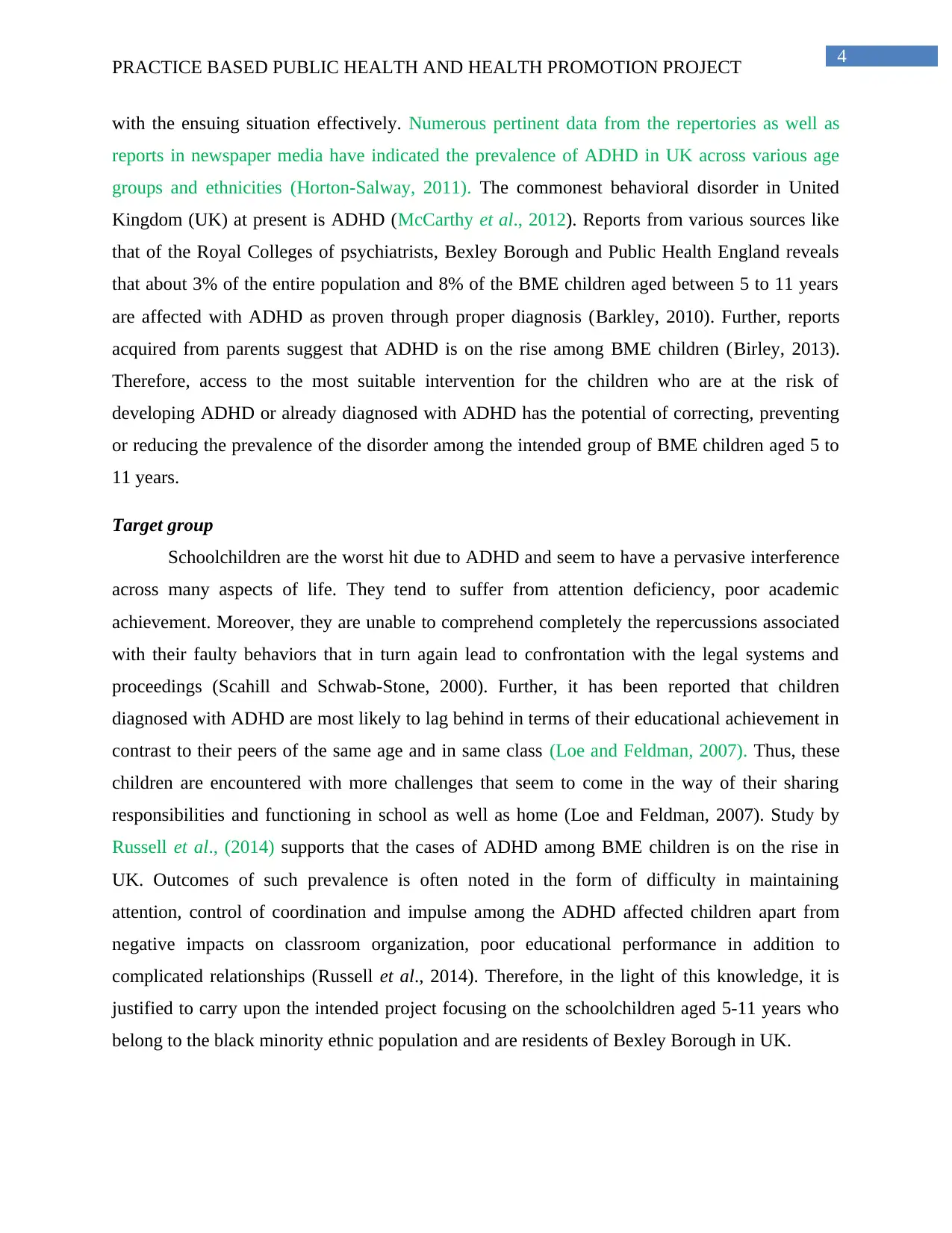
4
PRACTICE BASED PUBLIC HEALTH AND HEALTH PROMOTION PROJECT
with the ensuing situation effectively. Numerous pertinent data from the repertories as well as
reports in newspaper media have indicated the prevalence of ADHD in UK across various age
groups and ethnicities (Horton-Salway, 2011). The commonest behavioral disorder in United
Kingdom (UK) at present is ADHD (McCarthy et al., 2012). Reports from various sources like
that of the Royal Colleges of psychiatrists, Bexley Borough and Public Health England reveals
that about 3% of the entire population and 8% of the BME children aged between 5 to 11 years
are affected with ADHD as proven through proper diagnosis (Barkley, 2010). Further, reports
acquired from parents suggest that ADHD is on the rise among BME children (Birley, 2013).
Therefore, access to the most suitable intervention for the children who are at the risk of
developing ADHD or already diagnosed with ADHD has the potential of correcting, preventing
or reducing the prevalence of the disorder among the intended group of BME children aged 5 to
11 years.
Target group
Schoolchildren are the worst hit due to ADHD and seem to have a pervasive interference
across many aspects of life. They tend to suffer from attention deficiency, poor academic
achievement. Moreover, they are unable to comprehend completely the repercussions associated
with their faulty behaviors that in turn again lead to confrontation with the legal systems and
proceedings (Scahill and Schwab-Stone, 2000). Further, it has been reported that children
diagnosed with ADHD are most likely to lag behind in terms of their educational achievement in
contrast to their peers of the same age and in same class (Loe and Feldman, 2007). Thus, these
children are encountered with more challenges that seem to come in the way of their sharing
responsibilities and functioning in school as well as home (Loe and Feldman, 2007). Study by
Russell et al., (2014) supports that the cases of ADHD among BME children is on the rise in
UK. Outcomes of such prevalence is often noted in the form of difficulty in maintaining
attention, control of coordination and impulse among the ADHD affected children apart from
negative impacts on classroom organization, poor educational performance in addition to
complicated relationships (Russell et al., 2014). Therefore, in the light of this knowledge, it is
justified to carry upon the intended project focusing on the schoolchildren aged 5-11 years who
belong to the black minority ethnic population and are residents of Bexley Borough in UK.
PRACTICE BASED PUBLIC HEALTH AND HEALTH PROMOTION PROJECT
with the ensuing situation effectively. Numerous pertinent data from the repertories as well as
reports in newspaper media have indicated the prevalence of ADHD in UK across various age
groups and ethnicities (Horton-Salway, 2011). The commonest behavioral disorder in United
Kingdom (UK) at present is ADHD (McCarthy et al., 2012). Reports from various sources like
that of the Royal Colleges of psychiatrists, Bexley Borough and Public Health England reveals
that about 3% of the entire population and 8% of the BME children aged between 5 to 11 years
are affected with ADHD as proven through proper diagnosis (Barkley, 2010). Further, reports
acquired from parents suggest that ADHD is on the rise among BME children (Birley, 2013).
Therefore, access to the most suitable intervention for the children who are at the risk of
developing ADHD or already diagnosed with ADHD has the potential of correcting, preventing
or reducing the prevalence of the disorder among the intended group of BME children aged 5 to
11 years.
Target group
Schoolchildren are the worst hit due to ADHD and seem to have a pervasive interference
across many aspects of life. They tend to suffer from attention deficiency, poor academic
achievement. Moreover, they are unable to comprehend completely the repercussions associated
with their faulty behaviors that in turn again lead to confrontation with the legal systems and
proceedings (Scahill and Schwab-Stone, 2000). Further, it has been reported that children
diagnosed with ADHD are most likely to lag behind in terms of their educational achievement in
contrast to their peers of the same age and in same class (Loe and Feldman, 2007). Thus, these
children are encountered with more challenges that seem to come in the way of their sharing
responsibilities and functioning in school as well as home (Loe and Feldman, 2007). Study by
Russell et al., (2014) supports that the cases of ADHD among BME children is on the rise in
UK. Outcomes of such prevalence is often noted in the form of difficulty in maintaining
attention, control of coordination and impulse among the ADHD affected children apart from
negative impacts on classroom organization, poor educational performance in addition to
complicated relationships (Russell et al., 2014). Therefore, in the light of this knowledge, it is
justified to carry upon the intended project focusing on the schoolchildren aged 5-11 years who
belong to the black minority ethnic population and are residents of Bexley Borough in UK.

5
PRACTICE BASED PUBLIC HEALTH AND HEALTH PROMOTION PROJECT
Aims
The primary focus of this project is to establish certain early intervention strategies for
black minority ethnic (BME) children belonging to the age range of 5 to 11 years, who are at the
risk of or are diagnosed with Attention deficit Hyperactivity Disorder (ADHD), and reside in the
Bexley borough of United Kingdom (UK). Thus, the intended project strives to investigate the
potential of the strategies applicable in order to reduce, correct and prevent the disorder through
interventions such as that of behavioral therapy, health change and parent’s support group
thereby serving the greater purpose of promoting good health.
Objectives
What are the early intervention strategies available to BME children aged 5-11 years old
who are at risk or have been diagnosed with ADHD residing in the Bexley Borough?
The prospective project attempts to address the following objectives:
1. To explore what are the causes of ADHD among Black Minority Ethnic children age 5-11
years old in Bexley Borough.
2. To evaluate the effectiveness of the current interventions in Bexley Borough.
3. To explore the opportunity and suitability of intervention that would reduce, minimize and
prevent ADHD.
4. To examine how the intervention might contribute to a reduction in health inequalities.
Identified need
Background and Social Determinants Cause of ADHD in Bexley Borough
The symptoms of ADHD can be grouped into two classes of behavioral problems, which
in turn are known as inattentiveness and hyperactivities and impulsiveness. Therefore, many of
the children diagnosed with ADHD would either fall into the two categories or have both the
inattentiveness and hyperactivities. However, children with inattentiveness condition and not
with the other condition are known to be suffering from attention deficit disorder (ADD). ADD
may not raise any concern because the symptoms may go unnoticed or less visible (nhs.uk,
2019).
PRACTICE BASED PUBLIC HEALTH AND HEALTH PROMOTION PROJECT
Aims
The primary focus of this project is to establish certain early intervention strategies for
black minority ethnic (BME) children belonging to the age range of 5 to 11 years, who are at the
risk of or are diagnosed with Attention deficit Hyperactivity Disorder (ADHD), and reside in the
Bexley borough of United Kingdom (UK). Thus, the intended project strives to investigate the
potential of the strategies applicable in order to reduce, correct and prevent the disorder through
interventions such as that of behavioral therapy, health change and parent’s support group
thereby serving the greater purpose of promoting good health.
Objectives
What are the early intervention strategies available to BME children aged 5-11 years old
who are at risk or have been diagnosed with ADHD residing in the Bexley Borough?
The prospective project attempts to address the following objectives:
1. To explore what are the causes of ADHD among Black Minority Ethnic children age 5-11
years old in Bexley Borough.
2. To evaluate the effectiveness of the current interventions in Bexley Borough.
3. To explore the opportunity and suitability of intervention that would reduce, minimize and
prevent ADHD.
4. To examine how the intervention might contribute to a reduction in health inequalities.
Identified need
Background and Social Determinants Cause of ADHD in Bexley Borough
The symptoms of ADHD can be grouped into two classes of behavioral problems, which
in turn are known as inattentiveness and hyperactivities and impulsiveness. Therefore, many of
the children diagnosed with ADHD would either fall into the two categories or have both the
inattentiveness and hyperactivities. However, children with inattentiveness condition and not
with the other condition are known to be suffering from attention deficit disorder (ADD). ADD
may not raise any concern because the symptoms may go unnoticed or less visible (nhs.uk,
2019).
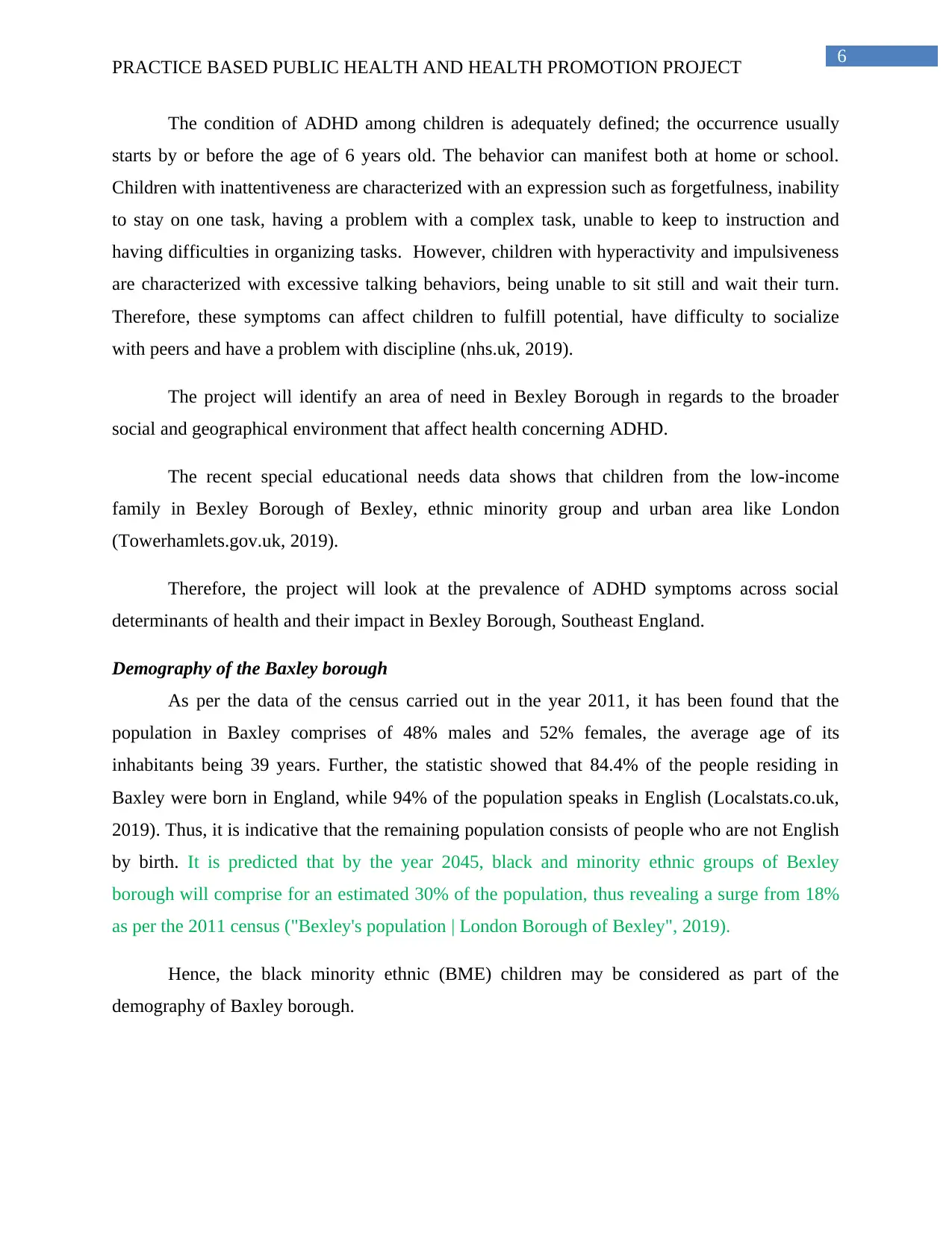
6
PRACTICE BASED PUBLIC HEALTH AND HEALTH PROMOTION PROJECT
The condition of ADHD among children is adequately defined; the occurrence usually
starts by or before the age of 6 years old. The behavior can manifest both at home or school.
Children with inattentiveness are characterized with an expression such as forgetfulness, inability
to stay on one task, having a problem with a complex task, unable to keep to instruction and
having difficulties in organizing tasks. However, children with hyperactivity and impulsiveness
are characterized with excessive talking behaviors, being unable to sit still and wait their turn.
Therefore, these symptoms can affect children to fulfill potential, have difficulty to socialize
with peers and have a problem with discipline (nhs.uk, 2019).
The project will identify an area of need in Bexley Borough in regards to the broader
social and geographical environment that affect health concerning ADHD.
The recent special educational needs data shows that children from the low-income
family in Bexley Borough of Bexley, ethnic minority group and urban area like London
(Towerhamlets.gov.uk, 2019).
Therefore, the project will look at the prevalence of ADHD symptoms across social
determinants of health and their impact in Bexley Borough, Southeast England.
Demography of the Baxley borough
As per the data of the census carried out in the year 2011, it has been found that the
population in Baxley comprises of 48% males and 52% females, the average age of its
inhabitants being 39 years. Further, the statistic showed that 84.4% of the people residing in
Baxley were born in England, while 94% of the population speaks in English (Localstats.co.uk,
2019). Thus, it is indicative that the remaining population consists of people who are not English
by birth. It is predicted that by the year 2045, black and minority ethnic groups of Bexley
borough will comprise for an estimated 30% of the population, thus revealing a surge from 18%
as per the 2011 census ("Bexley's population | London Borough of Bexley", 2019).
Hence, the black minority ethnic (BME) children may be considered as part of the
demography of Baxley borough.
PRACTICE BASED PUBLIC HEALTH AND HEALTH PROMOTION PROJECT
The condition of ADHD among children is adequately defined; the occurrence usually
starts by or before the age of 6 years old. The behavior can manifest both at home or school.
Children with inattentiveness are characterized with an expression such as forgetfulness, inability
to stay on one task, having a problem with a complex task, unable to keep to instruction and
having difficulties in organizing tasks. However, children with hyperactivity and impulsiveness
are characterized with excessive talking behaviors, being unable to sit still and wait their turn.
Therefore, these symptoms can affect children to fulfill potential, have difficulty to socialize
with peers and have a problem with discipline (nhs.uk, 2019).
The project will identify an area of need in Bexley Borough in regards to the broader
social and geographical environment that affect health concerning ADHD.
The recent special educational needs data shows that children from the low-income
family in Bexley Borough of Bexley, ethnic minority group and urban area like London
(Towerhamlets.gov.uk, 2019).
Therefore, the project will look at the prevalence of ADHD symptoms across social
determinants of health and their impact in Bexley Borough, Southeast England.
Demography of the Baxley borough
As per the data of the census carried out in the year 2011, it has been found that the
population in Baxley comprises of 48% males and 52% females, the average age of its
inhabitants being 39 years. Further, the statistic showed that 84.4% of the people residing in
Baxley were born in England, while 94% of the population speaks in English (Localstats.co.uk,
2019). Thus, it is indicative that the remaining population consists of people who are not English
by birth. It is predicted that by the year 2045, black and minority ethnic groups of Bexley
borough will comprise for an estimated 30% of the population, thus revealing a surge from 18%
as per the 2011 census ("Bexley's population | London Borough of Bexley", 2019).
Hence, the black minority ethnic (BME) children may be considered as part of the
demography of Baxley borough.
Secure Best Marks with AI Grader
Need help grading? Try our AI Grader for instant feedback on your assignments.
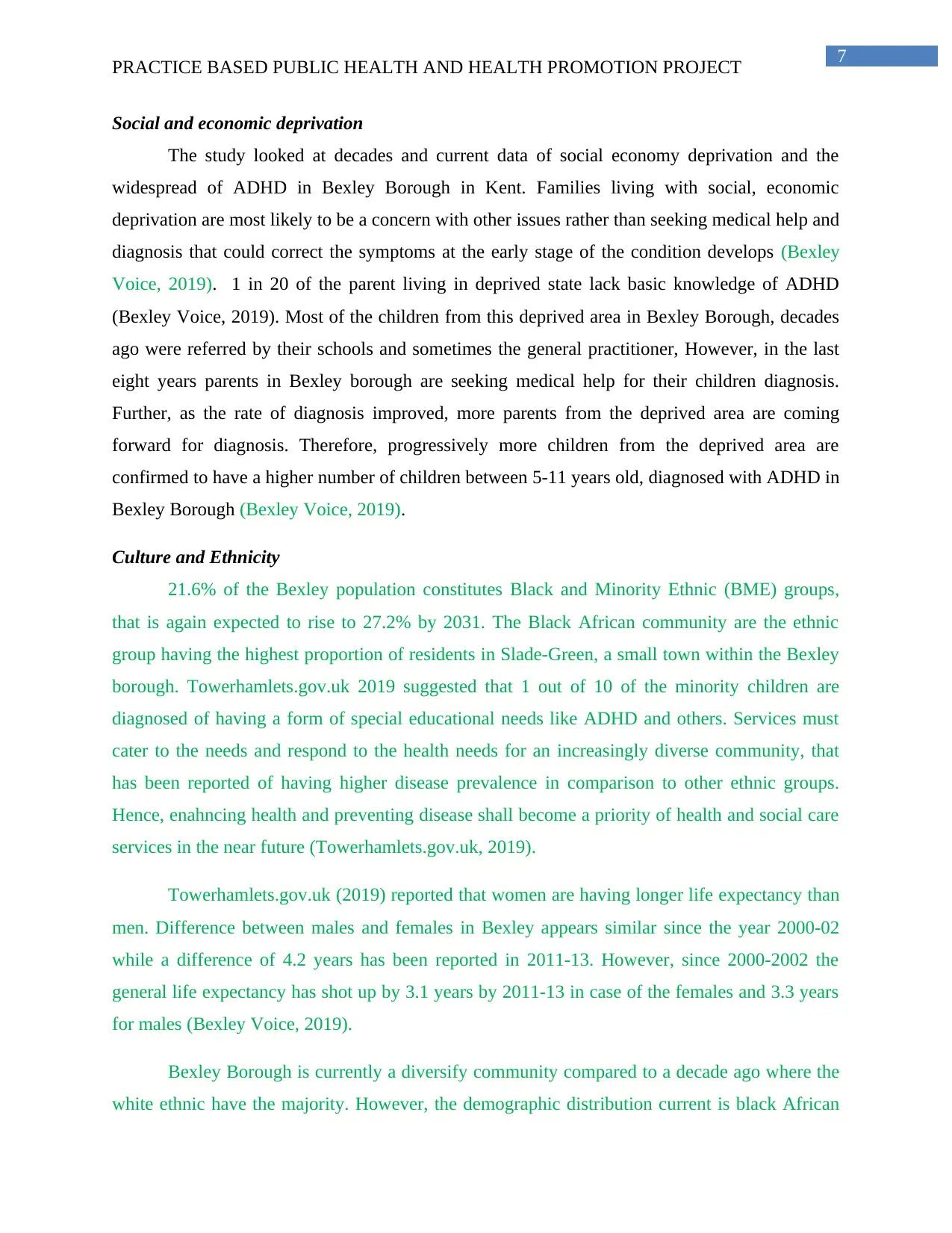
7
PRACTICE BASED PUBLIC HEALTH AND HEALTH PROMOTION PROJECT
Social and economic deprivation
The study looked at decades and current data of social economy deprivation and the
widespread of ADHD in Bexley Borough in Kent. Families living with social, economic
deprivation are most likely to be a concern with other issues rather than seeking medical help and
diagnosis that could correct the symptoms at the early stage of the condition develops (Bexley
Voice, 2019). 1 in 20 of the parent living in deprived state lack basic knowledge of ADHD
(Bexley Voice, 2019). Most of the children from this deprived area in Bexley Borough, decades
ago were referred by their schools and sometimes the general practitioner, However, in the last
eight years parents in Bexley borough are seeking medical help for their children diagnosis.
Further, as the rate of diagnosis improved, more parents from the deprived area are coming
forward for diagnosis. Therefore, progressively more children from the deprived area are
confirmed to have a higher number of children between 5-11 years old, diagnosed with ADHD in
Bexley Borough (Bexley Voice, 2019).
Culture and Ethnicity
21.6% of the Bexley population constitutes Black and Minority Ethnic (BME) groups,
that is again expected to rise to 27.2% by 2031. The Black African community are the ethnic
group having the highest proportion of residents in Slade-Green, a small town within the Bexley
borough. Towerhamlets.gov.uk 2019 suggested that 1 out of 10 of the minority children are
diagnosed of having a form of special educational needs like ADHD and others. Services must
cater to the needs and respond to the health needs for an increasingly diverse community, that
has been reported of having higher disease prevalence in comparison to other ethnic groups.
Hence, enahncing health and preventing disease shall become a priority of health and social care
services in the near future (Towerhamlets.gov.uk, 2019).
Towerhamlets.gov.uk (2019) reported that women are having longer life expectancy than
men. Difference between males and females in Bexley appears similar since the year 2000-02
while a difference of 4.2 years has been reported in 2011-13. However, since 2000-2002 the
general life expectancy has shot up by 3.1 years by 2011-13 in case of the females and 3.3 years
for males (Bexley Voice, 2019).
Bexley Borough is currently a diversify community compared to a decade ago where the
white ethnic have the majority. However, the demographic distribution current is black African
PRACTICE BASED PUBLIC HEALTH AND HEALTH PROMOTION PROJECT
Social and economic deprivation
The study looked at decades and current data of social economy deprivation and the
widespread of ADHD in Bexley Borough in Kent. Families living with social, economic
deprivation are most likely to be a concern with other issues rather than seeking medical help and
diagnosis that could correct the symptoms at the early stage of the condition develops (Bexley
Voice, 2019). 1 in 20 of the parent living in deprived state lack basic knowledge of ADHD
(Bexley Voice, 2019). Most of the children from this deprived area in Bexley Borough, decades
ago were referred by their schools and sometimes the general practitioner, However, in the last
eight years parents in Bexley borough are seeking medical help for their children diagnosis.
Further, as the rate of diagnosis improved, more parents from the deprived area are coming
forward for diagnosis. Therefore, progressively more children from the deprived area are
confirmed to have a higher number of children between 5-11 years old, diagnosed with ADHD in
Bexley Borough (Bexley Voice, 2019).
Culture and Ethnicity
21.6% of the Bexley population constitutes Black and Minority Ethnic (BME) groups,
that is again expected to rise to 27.2% by 2031. The Black African community are the ethnic
group having the highest proportion of residents in Slade-Green, a small town within the Bexley
borough. Towerhamlets.gov.uk 2019 suggested that 1 out of 10 of the minority children are
diagnosed of having a form of special educational needs like ADHD and others. Services must
cater to the needs and respond to the health needs for an increasingly diverse community, that
has been reported of having higher disease prevalence in comparison to other ethnic groups.
Hence, enahncing health and preventing disease shall become a priority of health and social care
services in the near future (Towerhamlets.gov.uk, 2019).
Towerhamlets.gov.uk (2019) reported that women are having longer life expectancy than
men. Difference between males and females in Bexley appears similar since the year 2000-02
while a difference of 4.2 years has been reported in 2011-13. However, since 2000-2002 the
general life expectancy has shot up by 3.1 years by 2011-13 in case of the females and 3.3 years
for males (Bexley Voice, 2019).
Bexley Borough is currently a diversify community compared to a decade ago where the
white ethnic have the majority. However, the demographic distribution current is black African
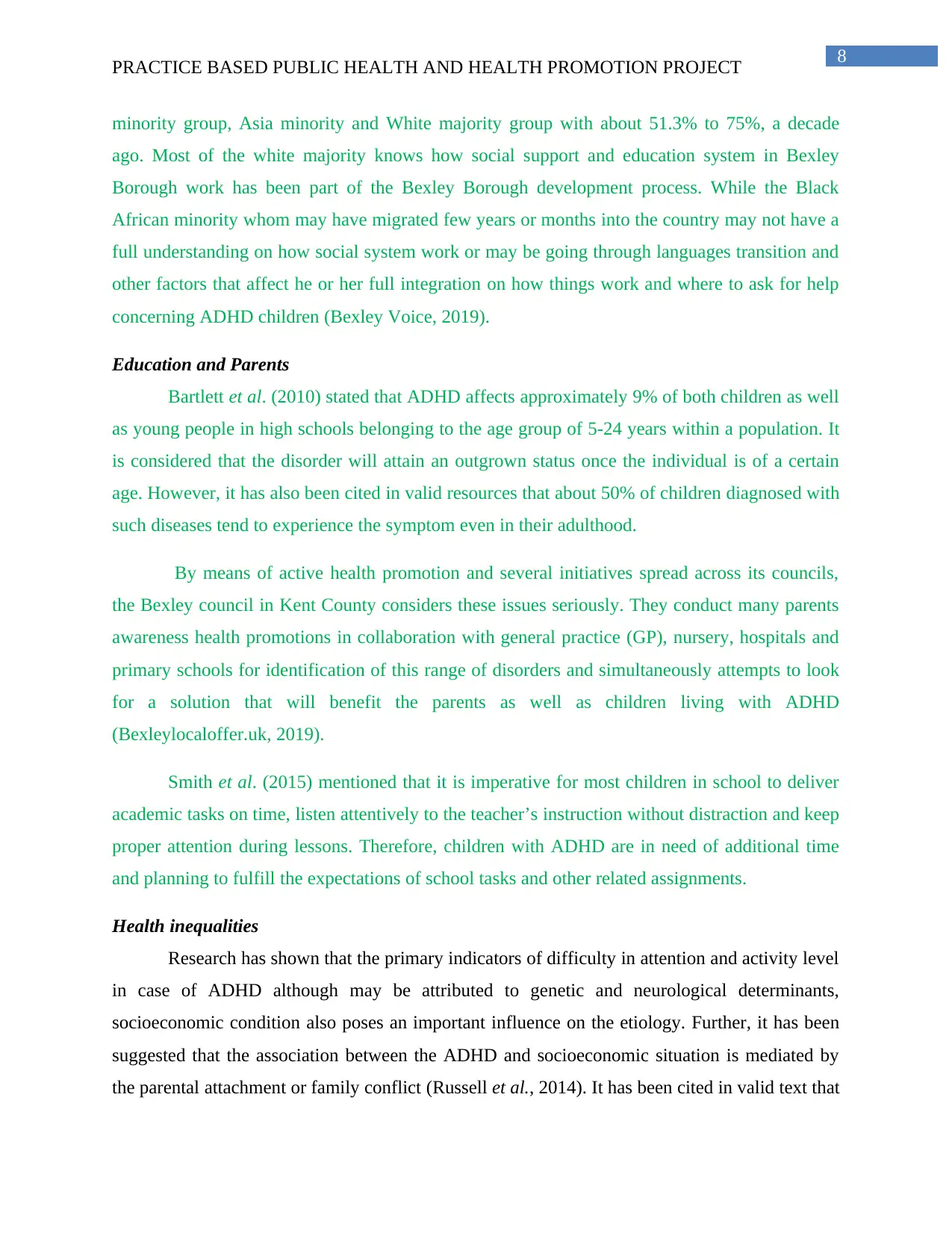
8
PRACTICE BASED PUBLIC HEALTH AND HEALTH PROMOTION PROJECT
minority group, Asia minority and White majority group with about 51.3% to 75%, a decade
ago. Most of the white majority knows how social support and education system in Bexley
Borough work has been part of the Bexley Borough development process. While the Black
African minority whom may have migrated few years or months into the country may not have a
full understanding on how social system work or may be going through languages transition and
other factors that affect he or her full integration on how things work and where to ask for help
concerning ADHD children (Bexley Voice, 2019).
Education and Parents
Bartlett et al. (2010) stated that ADHD affects approximately 9% of both children as well
as young people in high schools belonging to the age group of 5-24 years within a population. It
is considered that the disorder will attain an outgrown status once the individual is of a certain
age. However, it has also been cited in valid resources that about 50% of children diagnosed with
such diseases tend to experience the symptom even in their adulthood.
By means of active health promotion and several initiatives spread across its councils,
the Bexley council in Kent County considers these issues seriously. They conduct many parents
awareness health promotions in collaboration with general practice (GP), nursery, hospitals and
primary schools for identification of this range of disorders and simultaneously attempts to look
for a solution that will benefit the parents as well as children living with ADHD
(Bexleylocaloffer.uk, 2019).
Smith et al. (2015) mentioned that it is imperative for most children in school to deliver
academic tasks on time, listen attentively to the teacher’s instruction without distraction and keep
proper attention during lessons. Therefore, children with ADHD are in need of additional time
and planning to fulfill the expectations of school tasks and other related assignments.
Health inequalities
Research has shown that the primary indicators of difficulty in attention and activity level
in case of ADHD although may be attributed to genetic and neurological determinants,
socioeconomic condition also poses an important influence on the etiology. Further, it has been
suggested that the association between the ADHD and socioeconomic situation is mediated by
the parental attachment or family conflict (Russell et al., 2014). It has been cited in valid text that
PRACTICE BASED PUBLIC HEALTH AND HEALTH PROMOTION PROJECT
minority group, Asia minority and White majority group with about 51.3% to 75%, a decade
ago. Most of the white majority knows how social support and education system in Bexley
Borough work has been part of the Bexley Borough development process. While the Black
African minority whom may have migrated few years or months into the country may not have a
full understanding on how social system work or may be going through languages transition and
other factors that affect he or her full integration on how things work and where to ask for help
concerning ADHD children (Bexley Voice, 2019).
Education and Parents
Bartlett et al. (2010) stated that ADHD affects approximately 9% of both children as well
as young people in high schools belonging to the age group of 5-24 years within a population. It
is considered that the disorder will attain an outgrown status once the individual is of a certain
age. However, it has also been cited in valid resources that about 50% of children diagnosed with
such diseases tend to experience the symptom even in their adulthood.
By means of active health promotion and several initiatives spread across its councils,
the Bexley council in Kent County considers these issues seriously. They conduct many parents
awareness health promotions in collaboration with general practice (GP), nursery, hospitals and
primary schools for identification of this range of disorders and simultaneously attempts to look
for a solution that will benefit the parents as well as children living with ADHD
(Bexleylocaloffer.uk, 2019).
Smith et al. (2015) mentioned that it is imperative for most children in school to deliver
academic tasks on time, listen attentively to the teacher’s instruction without distraction and keep
proper attention during lessons. Therefore, children with ADHD are in need of additional time
and planning to fulfill the expectations of school tasks and other related assignments.
Health inequalities
Research has shown that the primary indicators of difficulty in attention and activity level
in case of ADHD although may be attributed to genetic and neurological determinants,
socioeconomic condition also poses an important influence on the etiology. Further, it has been
suggested that the association between the ADHD and socioeconomic situation is mediated by
the parental attachment or family conflict (Russell et al., 2014). It has been cited in valid text that
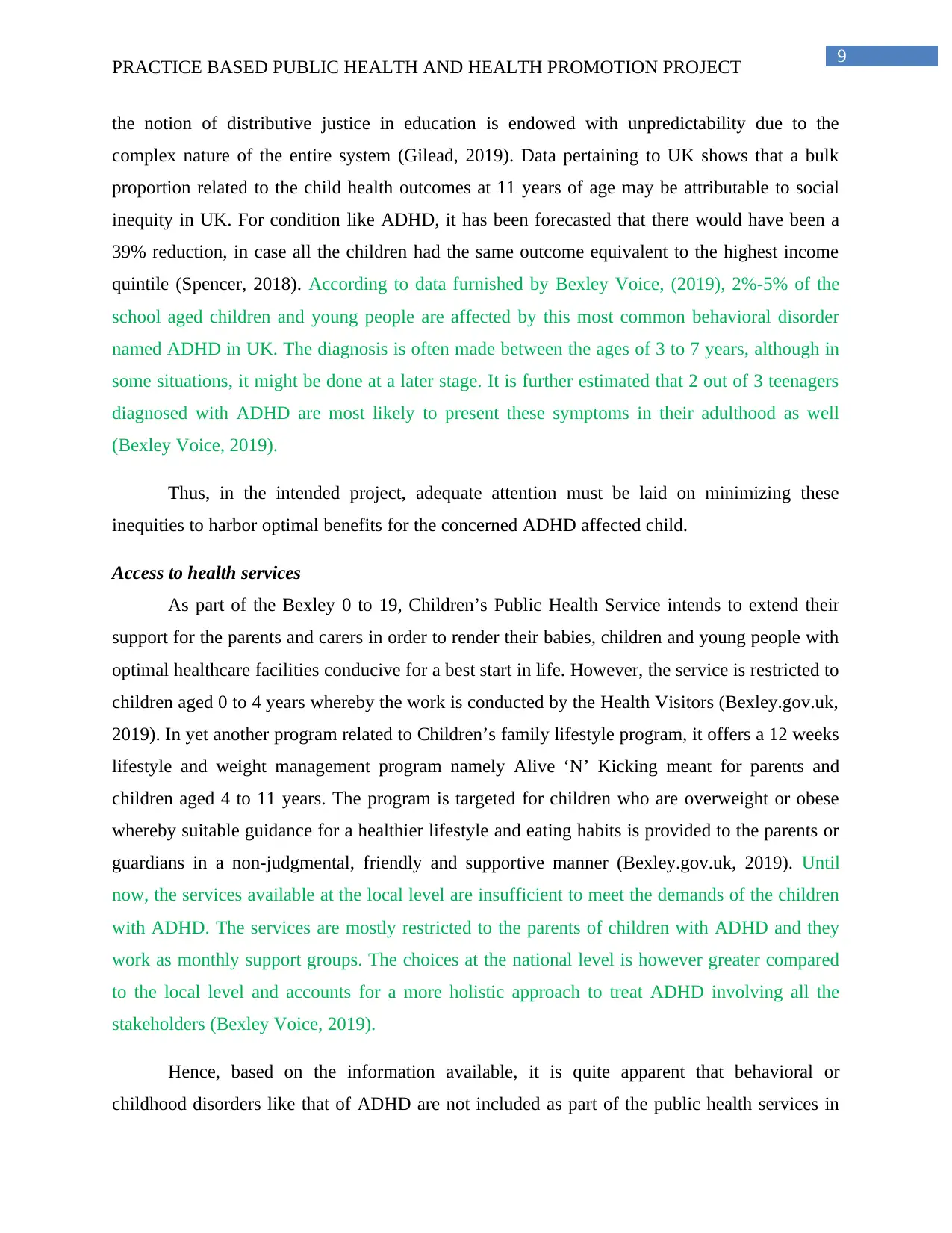
9
PRACTICE BASED PUBLIC HEALTH AND HEALTH PROMOTION PROJECT
the notion of distributive justice in education is endowed with unpredictability due to the
complex nature of the entire system (Gilead, 2019). Data pertaining to UK shows that a bulk
proportion related to the child health outcomes at 11 years of age may be attributable to social
inequity in UK. For condition like ADHD, it has been forecasted that there would have been a
39% reduction, in case all the children had the same outcome equivalent to the highest income
quintile (Spencer, 2018). According to data furnished by Bexley Voice, (2019), 2%-5% of the
school aged children and young people are affected by this most common behavioral disorder
named ADHD in UK. The diagnosis is often made between the ages of 3 to 7 years, although in
some situations, it might be done at a later stage. It is further estimated that 2 out of 3 teenagers
diagnosed with ADHD are most likely to present these symptoms in their adulthood as well
(Bexley Voice, 2019).
Thus, in the intended project, adequate attention must be laid on minimizing these
inequities to harbor optimal benefits for the concerned ADHD affected child.
Access to health services
As part of the Bexley 0 to 19, Children’s Public Health Service intends to extend their
support for the parents and carers in order to render their babies, children and young people with
optimal healthcare facilities conducive for a best start in life. However, the service is restricted to
children aged 0 to 4 years whereby the work is conducted by the Health Visitors (Bexley.gov.uk,
2019). In yet another program related to Children’s family lifestyle program, it offers a 12 weeks
lifestyle and weight management program namely Alive ‘N’ Kicking meant for parents and
children aged 4 to 11 years. The program is targeted for children who are overweight or obese
whereby suitable guidance for a healthier lifestyle and eating habits is provided to the parents or
guardians in a non-judgmental, friendly and supportive manner (Bexley.gov.uk, 2019). Until
now, the services available at the local level are insufficient to meet the demands of the children
with ADHD. The services are mostly restricted to the parents of children with ADHD and they
work as monthly support groups. The choices at the national level is however greater compared
to the local level and accounts for a more holistic approach to treat ADHD involving all the
stakeholders (Bexley Voice, 2019).
Hence, based on the information available, it is quite apparent that behavioral or
childhood disorders like that of ADHD are not included as part of the public health services in
PRACTICE BASED PUBLIC HEALTH AND HEALTH PROMOTION PROJECT
the notion of distributive justice in education is endowed with unpredictability due to the
complex nature of the entire system (Gilead, 2019). Data pertaining to UK shows that a bulk
proportion related to the child health outcomes at 11 years of age may be attributable to social
inequity in UK. For condition like ADHD, it has been forecasted that there would have been a
39% reduction, in case all the children had the same outcome equivalent to the highest income
quintile (Spencer, 2018). According to data furnished by Bexley Voice, (2019), 2%-5% of the
school aged children and young people are affected by this most common behavioral disorder
named ADHD in UK. The diagnosis is often made between the ages of 3 to 7 years, although in
some situations, it might be done at a later stage. It is further estimated that 2 out of 3 teenagers
diagnosed with ADHD are most likely to present these symptoms in their adulthood as well
(Bexley Voice, 2019).
Thus, in the intended project, adequate attention must be laid on minimizing these
inequities to harbor optimal benefits for the concerned ADHD affected child.
Access to health services
As part of the Bexley 0 to 19, Children’s Public Health Service intends to extend their
support for the parents and carers in order to render their babies, children and young people with
optimal healthcare facilities conducive for a best start in life. However, the service is restricted to
children aged 0 to 4 years whereby the work is conducted by the Health Visitors (Bexley.gov.uk,
2019). In yet another program related to Children’s family lifestyle program, it offers a 12 weeks
lifestyle and weight management program namely Alive ‘N’ Kicking meant for parents and
children aged 4 to 11 years. The program is targeted for children who are overweight or obese
whereby suitable guidance for a healthier lifestyle and eating habits is provided to the parents or
guardians in a non-judgmental, friendly and supportive manner (Bexley.gov.uk, 2019). Until
now, the services available at the local level are insufficient to meet the demands of the children
with ADHD. The services are mostly restricted to the parents of children with ADHD and they
work as monthly support groups. The choices at the national level is however greater compared
to the local level and accounts for a more holistic approach to treat ADHD involving all the
stakeholders (Bexley Voice, 2019).
Hence, based on the information available, it is quite apparent that behavioral or
childhood disorders like that of ADHD are not included as part of the public health services in
Paraphrase This Document
Need a fresh take? Get an instant paraphrase of this document with our AI Paraphraser
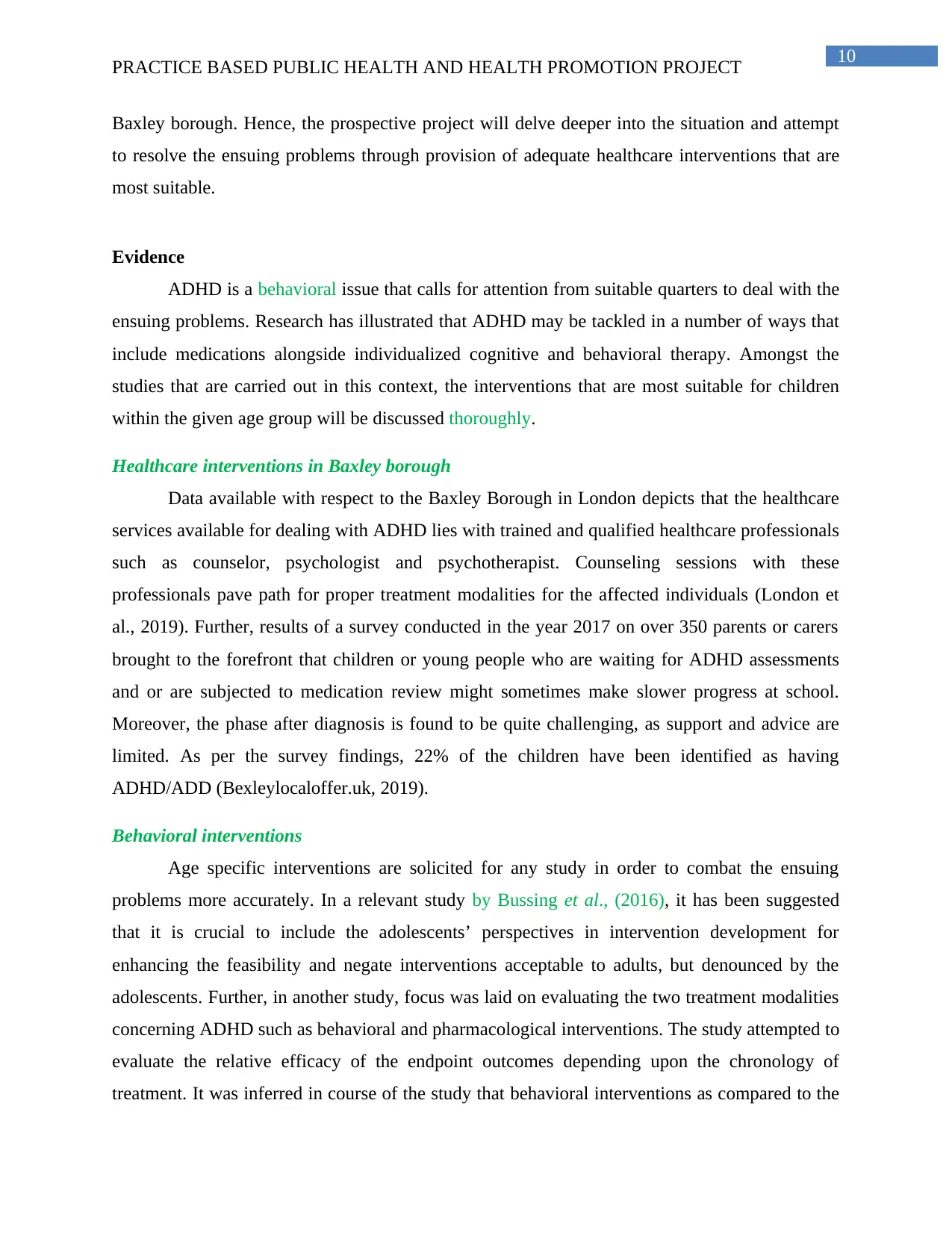
10
PRACTICE BASED PUBLIC HEALTH AND HEALTH PROMOTION PROJECT
Baxley borough. Hence, the prospective project will delve deeper into the situation and attempt
to resolve the ensuing problems through provision of adequate healthcare interventions that are
most suitable.
Evidence
ADHD is a behavioral issue that calls for attention from suitable quarters to deal with the
ensuing problems. Research has illustrated that ADHD may be tackled in a number of ways that
include medications alongside individualized cognitive and behavioral therapy. Amongst the
studies that are carried out in this context, the interventions that are most suitable for children
within the given age group will be discussed thoroughly.
Healthcare interventions in Baxley borough
Data available with respect to the Baxley Borough in London depicts that the healthcare
services available for dealing with ADHD lies with trained and qualified healthcare professionals
such as counselor, psychologist and psychotherapist. Counseling sessions with these
professionals pave path for proper treatment modalities for the affected individuals (London et
al., 2019). Further, results of a survey conducted in the year 2017 on over 350 parents or carers
brought to the forefront that children or young people who are waiting for ADHD assessments
and or are subjected to medication review might sometimes make slower progress at school.
Moreover, the phase after diagnosis is found to be quite challenging, as support and advice are
limited. As per the survey findings, 22% of the children have been identified as having
ADHD/ADD (Bexleylocaloffer.uk, 2019).
Behavioral interventions
Age specific interventions are solicited for any study in order to combat the ensuing
problems more accurately. In a relevant study by Bussing et al., (2016), it has been suggested
that it is crucial to include the adolescents’ perspectives in intervention development for
enhancing the feasibility and negate interventions acceptable to adults, but denounced by the
adolescents. Further, in another study, focus was laid on evaluating the two treatment modalities
concerning ADHD such as behavioral and pharmacological interventions. The study attempted to
evaluate the relative efficacy of the endpoint outcomes depending upon the chronology of
treatment. It was inferred in course of the study that behavioral interventions as compared to the
PRACTICE BASED PUBLIC HEALTH AND HEALTH PROMOTION PROJECT
Baxley borough. Hence, the prospective project will delve deeper into the situation and attempt
to resolve the ensuing problems through provision of adequate healthcare interventions that are
most suitable.
Evidence
ADHD is a behavioral issue that calls for attention from suitable quarters to deal with the
ensuing problems. Research has illustrated that ADHD may be tackled in a number of ways that
include medications alongside individualized cognitive and behavioral therapy. Amongst the
studies that are carried out in this context, the interventions that are most suitable for children
within the given age group will be discussed thoroughly.
Healthcare interventions in Baxley borough
Data available with respect to the Baxley Borough in London depicts that the healthcare
services available for dealing with ADHD lies with trained and qualified healthcare professionals
such as counselor, psychologist and psychotherapist. Counseling sessions with these
professionals pave path for proper treatment modalities for the affected individuals (London et
al., 2019). Further, results of a survey conducted in the year 2017 on over 350 parents or carers
brought to the forefront that children or young people who are waiting for ADHD assessments
and or are subjected to medication review might sometimes make slower progress at school.
Moreover, the phase after diagnosis is found to be quite challenging, as support and advice are
limited. As per the survey findings, 22% of the children have been identified as having
ADHD/ADD (Bexleylocaloffer.uk, 2019).
Behavioral interventions
Age specific interventions are solicited for any study in order to combat the ensuing
problems more accurately. In a relevant study by Bussing et al., (2016), it has been suggested
that it is crucial to include the adolescents’ perspectives in intervention development for
enhancing the feasibility and negate interventions acceptable to adults, but denounced by the
adolescents. Further, in another study, focus was laid on evaluating the two treatment modalities
concerning ADHD such as behavioral and pharmacological interventions. The study attempted to
evaluate the relative efficacy of the endpoint outcomes depending upon the chronology of
treatment. It was inferred in course of the study that behavioral interventions as compared to the
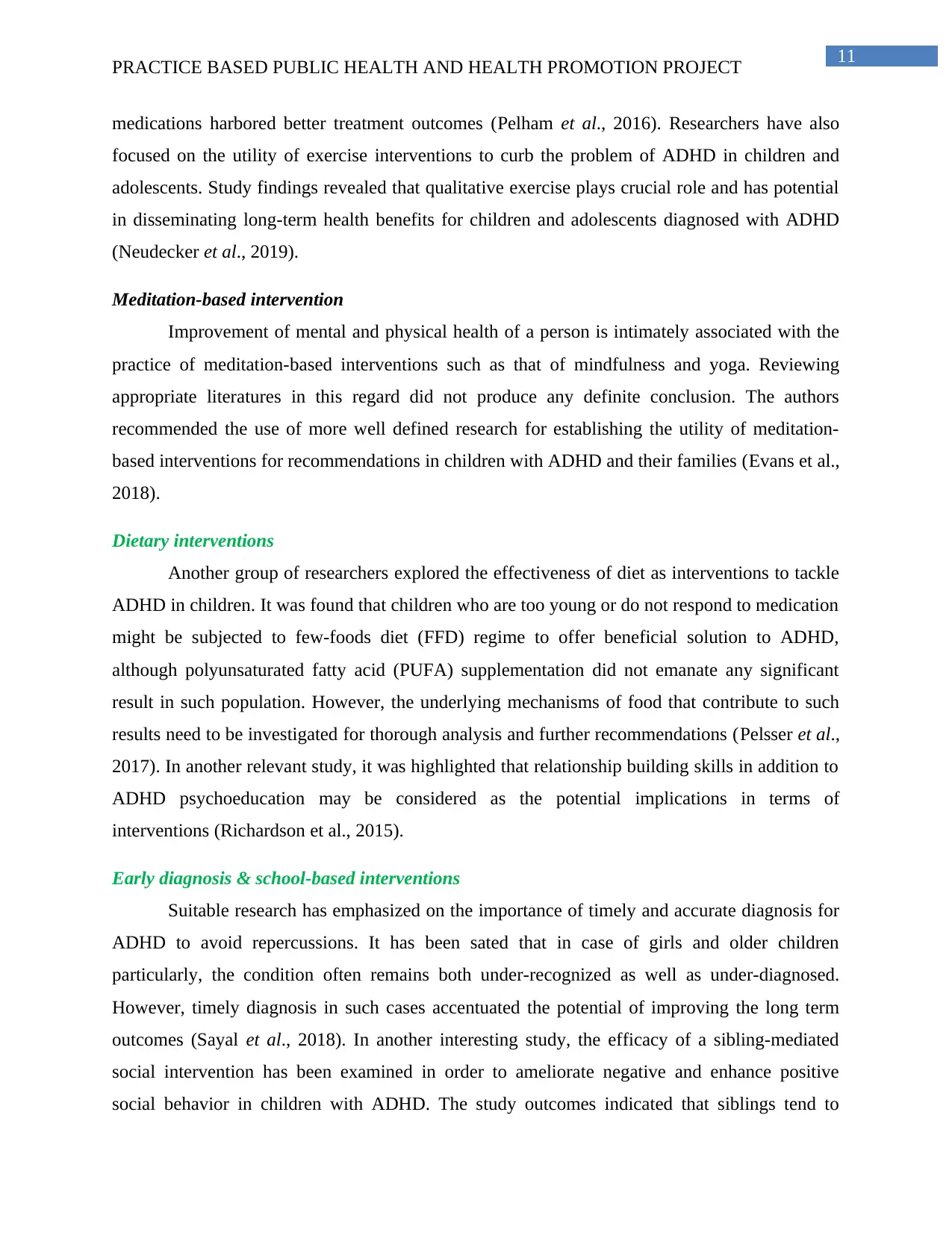
11
PRACTICE BASED PUBLIC HEALTH AND HEALTH PROMOTION PROJECT
medications harbored better treatment outcomes (Pelham et al., 2016). Researchers have also
focused on the utility of exercise interventions to curb the problem of ADHD in children and
adolescents. Study findings revealed that qualitative exercise plays crucial role and has potential
in disseminating long-term health benefits for children and adolescents diagnosed with ADHD
(Neudecker et al., 2019).
Meditation-based intervention
Improvement of mental and physical health of a person is intimately associated with the
practice of meditation-based interventions such as that of mindfulness and yoga. Reviewing
appropriate literatures in this regard did not produce any definite conclusion. The authors
recommended the use of more well defined research for establishing the utility of meditation-
based interventions for recommendations in children with ADHD and their families (Evans et al.,
2018).
Dietary interventions
Another group of researchers explored the effectiveness of diet as interventions to tackle
ADHD in children. It was found that children who are too young or do not respond to medication
might be subjected to few-foods diet (FFD) regime to offer beneficial solution to ADHD,
although polyunsaturated fatty acid (PUFA) supplementation did not emanate any significant
result in such population. However, the underlying mechanisms of food that contribute to such
results need to be investigated for thorough analysis and further recommendations (Pelsser et al.,
2017). In another relevant study, it was highlighted that relationship building skills in addition to
ADHD psychoeducation may be considered as the potential implications in terms of
interventions (Richardson et al., 2015).
Early diagnosis & school-based interventions
Suitable research has emphasized on the importance of timely and accurate diagnosis for
ADHD to avoid repercussions. It has been sated that in case of girls and older children
particularly, the condition often remains both under-recognized as well as under-diagnosed.
However, timely diagnosis in such cases accentuated the potential of improving the long term
outcomes (Sayal et al., 2018). In another interesting study, the efficacy of a sibling-mediated
social intervention has been examined in order to ameliorate negative and enhance positive
social behavior in children with ADHD. The study outcomes indicated that siblings tend to
PRACTICE BASED PUBLIC HEALTH AND HEALTH PROMOTION PROJECT
medications harbored better treatment outcomes (Pelham et al., 2016). Researchers have also
focused on the utility of exercise interventions to curb the problem of ADHD in children and
adolescents. Study findings revealed that qualitative exercise plays crucial role and has potential
in disseminating long-term health benefits for children and adolescents diagnosed with ADHD
(Neudecker et al., 2019).
Meditation-based intervention
Improvement of mental and physical health of a person is intimately associated with the
practice of meditation-based interventions such as that of mindfulness and yoga. Reviewing
appropriate literatures in this regard did not produce any definite conclusion. The authors
recommended the use of more well defined research for establishing the utility of meditation-
based interventions for recommendations in children with ADHD and their families (Evans et al.,
2018).
Dietary interventions
Another group of researchers explored the effectiveness of diet as interventions to tackle
ADHD in children. It was found that children who are too young or do not respond to medication
might be subjected to few-foods diet (FFD) regime to offer beneficial solution to ADHD,
although polyunsaturated fatty acid (PUFA) supplementation did not emanate any significant
result in such population. However, the underlying mechanisms of food that contribute to such
results need to be investigated for thorough analysis and further recommendations (Pelsser et al.,
2017). In another relevant study, it was highlighted that relationship building skills in addition to
ADHD psychoeducation may be considered as the potential implications in terms of
interventions (Richardson et al., 2015).
Early diagnosis & school-based interventions
Suitable research has emphasized on the importance of timely and accurate diagnosis for
ADHD to avoid repercussions. It has been sated that in case of girls and older children
particularly, the condition often remains both under-recognized as well as under-diagnosed.
However, timely diagnosis in such cases accentuated the potential of improving the long term
outcomes (Sayal et al., 2018). In another interesting study, the efficacy of a sibling-mediated
social intervention has been examined in order to ameliorate negative and enhance positive
social behavior in children with ADHD. The study outcomes indicated that siblings tend to
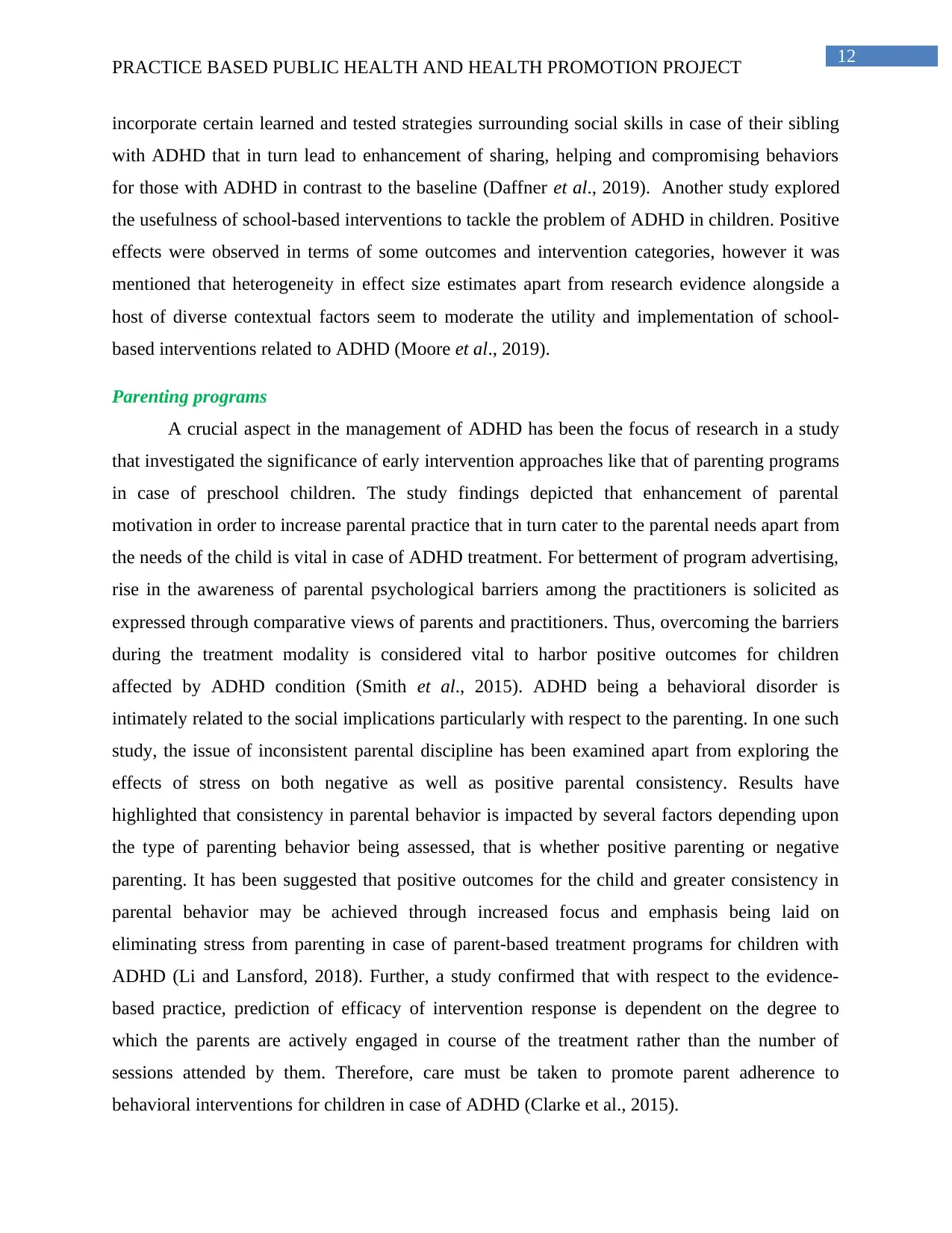
12
PRACTICE BASED PUBLIC HEALTH AND HEALTH PROMOTION PROJECT
incorporate certain learned and tested strategies surrounding social skills in case of their sibling
with ADHD that in turn lead to enhancement of sharing, helping and compromising behaviors
for those with ADHD in contrast to the baseline (Daffner et al., 2019). Another study explored
the usefulness of school-based interventions to tackle the problem of ADHD in children. Positive
effects were observed in terms of some outcomes and intervention categories, however it was
mentioned that heterogeneity in effect size estimates apart from research evidence alongside a
host of diverse contextual factors seem to moderate the utility and implementation of school-
based interventions related to ADHD (Moore et al., 2019).
Parenting programs
A crucial aspect in the management of ADHD has been the focus of research in a study
that investigated the significance of early intervention approaches like that of parenting programs
in case of preschool children. The study findings depicted that enhancement of parental
motivation in order to increase parental practice that in turn cater to the parental needs apart from
the needs of the child is vital in case of ADHD treatment. For betterment of program advertising,
rise in the awareness of parental psychological barriers among the practitioners is solicited as
expressed through comparative views of parents and practitioners. Thus, overcoming the barriers
during the treatment modality is considered vital to harbor positive outcomes for children
affected by ADHD condition (Smith et al., 2015). ADHD being a behavioral disorder is
intimately related to the social implications particularly with respect to the parenting. In one such
study, the issue of inconsistent parental discipline has been examined apart from exploring the
effects of stress on both negative as well as positive parental consistency. Results have
highlighted that consistency in parental behavior is impacted by several factors depending upon
the type of parenting behavior being assessed, that is whether positive parenting or negative
parenting. It has been suggested that positive outcomes for the child and greater consistency in
parental behavior may be achieved through increased focus and emphasis being laid on
eliminating stress from parenting in case of parent-based treatment programs for children with
ADHD (Li and Lansford, 2018). Further, a study confirmed that with respect to the evidence-
based practice, prediction of efficacy of intervention response is dependent on the degree to
which the parents are actively engaged in course of the treatment rather than the number of
sessions attended by them. Therefore, care must be taken to promote parent adherence to
behavioral interventions for children in case of ADHD (Clarke et al., 2015).
PRACTICE BASED PUBLIC HEALTH AND HEALTH PROMOTION PROJECT
incorporate certain learned and tested strategies surrounding social skills in case of their sibling
with ADHD that in turn lead to enhancement of sharing, helping and compromising behaviors
for those with ADHD in contrast to the baseline (Daffner et al., 2019). Another study explored
the usefulness of school-based interventions to tackle the problem of ADHD in children. Positive
effects were observed in terms of some outcomes and intervention categories, however it was
mentioned that heterogeneity in effect size estimates apart from research evidence alongside a
host of diverse contextual factors seem to moderate the utility and implementation of school-
based interventions related to ADHD (Moore et al., 2019).
Parenting programs
A crucial aspect in the management of ADHD has been the focus of research in a study
that investigated the significance of early intervention approaches like that of parenting programs
in case of preschool children. The study findings depicted that enhancement of parental
motivation in order to increase parental practice that in turn cater to the parental needs apart from
the needs of the child is vital in case of ADHD treatment. For betterment of program advertising,
rise in the awareness of parental psychological barriers among the practitioners is solicited as
expressed through comparative views of parents and practitioners. Thus, overcoming the barriers
during the treatment modality is considered vital to harbor positive outcomes for children
affected by ADHD condition (Smith et al., 2015). ADHD being a behavioral disorder is
intimately related to the social implications particularly with respect to the parenting. In one such
study, the issue of inconsistent parental discipline has been examined apart from exploring the
effects of stress on both negative as well as positive parental consistency. Results have
highlighted that consistency in parental behavior is impacted by several factors depending upon
the type of parenting behavior being assessed, that is whether positive parenting or negative
parenting. It has been suggested that positive outcomes for the child and greater consistency in
parental behavior may be achieved through increased focus and emphasis being laid on
eliminating stress from parenting in case of parent-based treatment programs for children with
ADHD (Li and Lansford, 2018). Further, a study confirmed that with respect to the evidence-
based practice, prediction of efficacy of intervention response is dependent on the degree to
which the parents are actively engaged in course of the treatment rather than the number of
sessions attended by them. Therefore, care must be taken to promote parent adherence to
behavioral interventions for children in case of ADHD (Clarke et al., 2015).
Secure Best Marks with AI Grader
Need help grading? Try our AI Grader for instant feedback on your assignments.
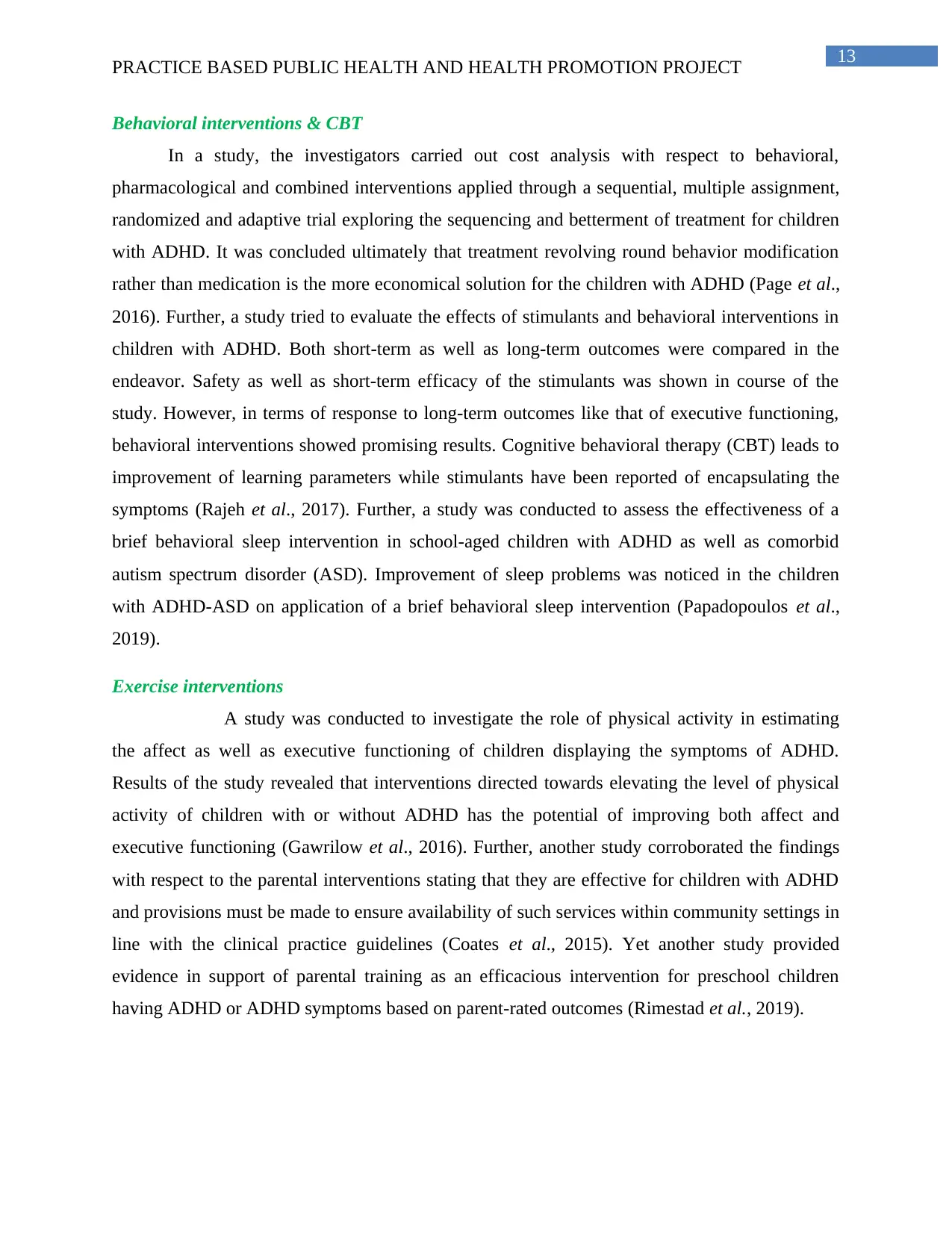
13
PRACTICE BASED PUBLIC HEALTH AND HEALTH PROMOTION PROJECT
Behavioral interventions & CBT
In a study, the investigators carried out cost analysis with respect to behavioral,
pharmacological and combined interventions applied through a sequential, multiple assignment,
randomized and adaptive trial exploring the sequencing and betterment of treatment for children
with ADHD. It was concluded ultimately that treatment revolving round behavior modification
rather than medication is the more economical solution for the children with ADHD (Page et al.,
2016). Further, a study tried to evaluate the effects of stimulants and behavioral interventions in
children with ADHD. Both short-term as well as long-term outcomes were compared in the
endeavor. Safety as well as short-term efficacy of the stimulants was shown in course of the
study. However, in terms of response to long-term outcomes like that of executive functioning,
behavioral interventions showed promising results. Cognitive behavioral therapy (CBT) leads to
improvement of learning parameters while stimulants have been reported of encapsulating the
symptoms (Rajeh et al., 2017). Further, a study was conducted to assess the effectiveness of a
brief behavioral sleep intervention in school-aged children with ADHD as well as comorbid
autism spectrum disorder (ASD). Improvement of sleep problems was noticed in the children
with ADHD-ASD on application of a brief behavioral sleep intervention (Papadopoulos et al.,
2019).
Exercise interventions
A study was conducted to investigate the role of physical activity in estimating
the affect as well as executive functioning of children displaying the symptoms of ADHD.
Results of the study revealed that interventions directed towards elevating the level of physical
activity of children with or without ADHD has the potential of improving both affect and
executive functioning (Gawrilow et al., 2016). Further, another study corroborated the findings
with respect to the parental interventions stating that they are effective for children with ADHD
and provisions must be made to ensure availability of such services within community settings in
line with the clinical practice guidelines (Coates et al., 2015). Yet another study provided
evidence in support of parental training as an efficacious intervention for preschool children
having ADHD or ADHD symptoms based on parent-rated outcomes (Rimestad et al., 2019).
PRACTICE BASED PUBLIC HEALTH AND HEALTH PROMOTION PROJECT
Behavioral interventions & CBT
In a study, the investigators carried out cost analysis with respect to behavioral,
pharmacological and combined interventions applied through a sequential, multiple assignment,
randomized and adaptive trial exploring the sequencing and betterment of treatment for children
with ADHD. It was concluded ultimately that treatment revolving round behavior modification
rather than medication is the more economical solution for the children with ADHD (Page et al.,
2016). Further, a study tried to evaluate the effects of stimulants and behavioral interventions in
children with ADHD. Both short-term as well as long-term outcomes were compared in the
endeavor. Safety as well as short-term efficacy of the stimulants was shown in course of the
study. However, in terms of response to long-term outcomes like that of executive functioning,
behavioral interventions showed promising results. Cognitive behavioral therapy (CBT) leads to
improvement of learning parameters while stimulants have been reported of encapsulating the
symptoms (Rajeh et al., 2017). Further, a study was conducted to assess the effectiveness of a
brief behavioral sleep intervention in school-aged children with ADHD as well as comorbid
autism spectrum disorder (ASD). Improvement of sleep problems was noticed in the children
with ADHD-ASD on application of a brief behavioral sleep intervention (Papadopoulos et al.,
2019).
Exercise interventions
A study was conducted to investigate the role of physical activity in estimating
the affect as well as executive functioning of children displaying the symptoms of ADHD.
Results of the study revealed that interventions directed towards elevating the level of physical
activity of children with or without ADHD has the potential of improving both affect and
executive functioning (Gawrilow et al., 2016). Further, another study corroborated the findings
with respect to the parental interventions stating that they are effective for children with ADHD
and provisions must be made to ensure availability of such services within community settings in
line with the clinical practice guidelines (Coates et al., 2015). Yet another study provided
evidence in support of parental training as an efficacious intervention for preschool children
having ADHD or ADHD symptoms based on parent-rated outcomes (Rimestad et al., 2019).
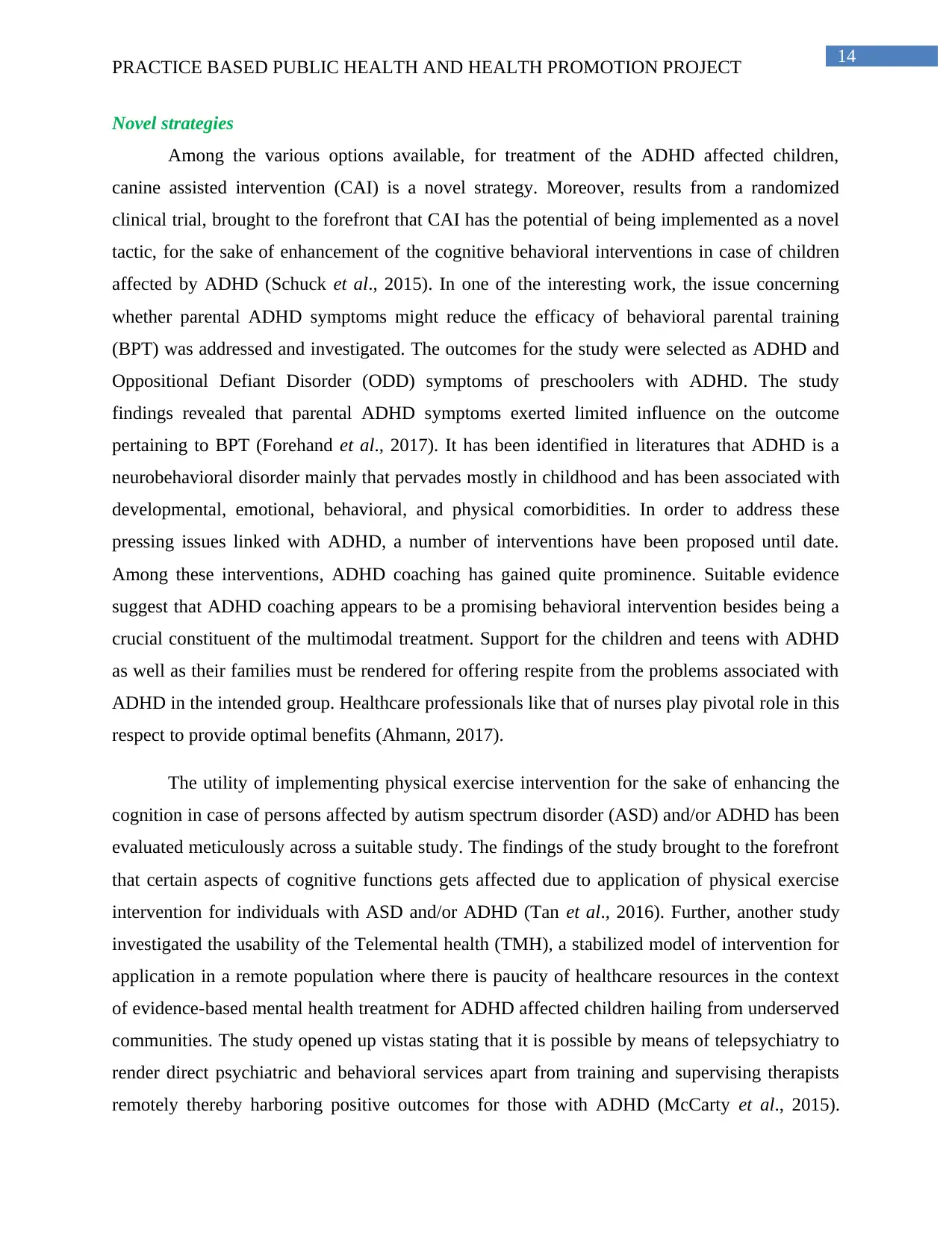
14
PRACTICE BASED PUBLIC HEALTH AND HEALTH PROMOTION PROJECT
Novel strategies
Among the various options available, for treatment of the ADHD affected children,
canine assisted intervention (CAI) is a novel strategy. Moreover, results from a randomized
clinical trial, brought to the forefront that CAI has the potential of being implemented as a novel
tactic, for the sake of enhancement of the cognitive behavioral interventions in case of children
affected by ADHD (Schuck et al., 2015). In one of the interesting work, the issue concerning
whether parental ADHD symptoms might reduce the efficacy of behavioral parental training
(BPT) was addressed and investigated. The outcomes for the study were selected as ADHD and
Oppositional Defiant Disorder (ODD) symptoms of preschoolers with ADHD. The study
findings revealed that parental ADHD symptoms exerted limited influence on the outcome
pertaining to BPT (Forehand et al., 2017). It has been identified in literatures that ADHD is a
neurobehavioral disorder mainly that pervades mostly in childhood and has been associated with
developmental, emotional, behavioral, and physical comorbidities. In order to address these
pressing issues linked with ADHD, a number of interventions have been proposed until date.
Among these interventions, ADHD coaching has gained quite prominence. Suitable evidence
suggest that ADHD coaching appears to be a promising behavioral intervention besides being a
crucial constituent of the multimodal treatment. Support for the children and teens with ADHD
as well as their families must be rendered for offering respite from the problems associated with
ADHD in the intended group. Healthcare professionals like that of nurses play pivotal role in this
respect to provide optimal benefits (Ahmann, 2017).
The utility of implementing physical exercise intervention for the sake of enhancing the
cognition in case of persons affected by autism spectrum disorder (ASD) and/or ADHD has been
evaluated meticulously across a suitable study. The findings of the study brought to the forefront
that certain aspects of cognitive functions gets affected due to application of physical exercise
intervention for individuals with ASD and/or ADHD (Tan et al., 2016). Further, another study
investigated the usability of the Telemental health (TMH), a stabilized model of intervention for
application in a remote population where there is paucity of healthcare resources in the context
of evidence-based mental health treatment for ADHD affected children hailing from underserved
communities. The study opened up vistas stating that it is possible by means of telepsychiatry to
render direct psychiatric and behavioral services apart from training and supervising therapists
remotely thereby harboring positive outcomes for those with ADHD (McCarty et al., 2015).
PRACTICE BASED PUBLIC HEALTH AND HEALTH PROMOTION PROJECT
Novel strategies
Among the various options available, for treatment of the ADHD affected children,
canine assisted intervention (CAI) is a novel strategy. Moreover, results from a randomized
clinical trial, brought to the forefront that CAI has the potential of being implemented as a novel
tactic, for the sake of enhancement of the cognitive behavioral interventions in case of children
affected by ADHD (Schuck et al., 2015). In one of the interesting work, the issue concerning
whether parental ADHD symptoms might reduce the efficacy of behavioral parental training
(BPT) was addressed and investigated. The outcomes for the study were selected as ADHD and
Oppositional Defiant Disorder (ODD) symptoms of preschoolers with ADHD. The study
findings revealed that parental ADHD symptoms exerted limited influence on the outcome
pertaining to BPT (Forehand et al., 2017). It has been identified in literatures that ADHD is a
neurobehavioral disorder mainly that pervades mostly in childhood and has been associated with
developmental, emotional, behavioral, and physical comorbidities. In order to address these
pressing issues linked with ADHD, a number of interventions have been proposed until date.
Among these interventions, ADHD coaching has gained quite prominence. Suitable evidence
suggest that ADHD coaching appears to be a promising behavioral intervention besides being a
crucial constituent of the multimodal treatment. Support for the children and teens with ADHD
as well as their families must be rendered for offering respite from the problems associated with
ADHD in the intended group. Healthcare professionals like that of nurses play pivotal role in this
respect to provide optimal benefits (Ahmann, 2017).
The utility of implementing physical exercise intervention for the sake of enhancing the
cognition in case of persons affected by autism spectrum disorder (ASD) and/or ADHD has been
evaluated meticulously across a suitable study. The findings of the study brought to the forefront
that certain aspects of cognitive functions gets affected due to application of physical exercise
intervention for individuals with ASD and/or ADHD (Tan et al., 2016). Further, another study
investigated the usability of the Telemental health (TMH), a stabilized model of intervention for
application in a remote population where there is paucity of healthcare resources in the context
of evidence-based mental health treatment for ADHD affected children hailing from underserved
communities. The study opened up vistas stating that it is possible by means of telepsychiatry to
render direct psychiatric and behavioral services apart from training and supervising therapists
remotely thereby harboring positive outcomes for those with ADHD (McCarty et al., 2015).
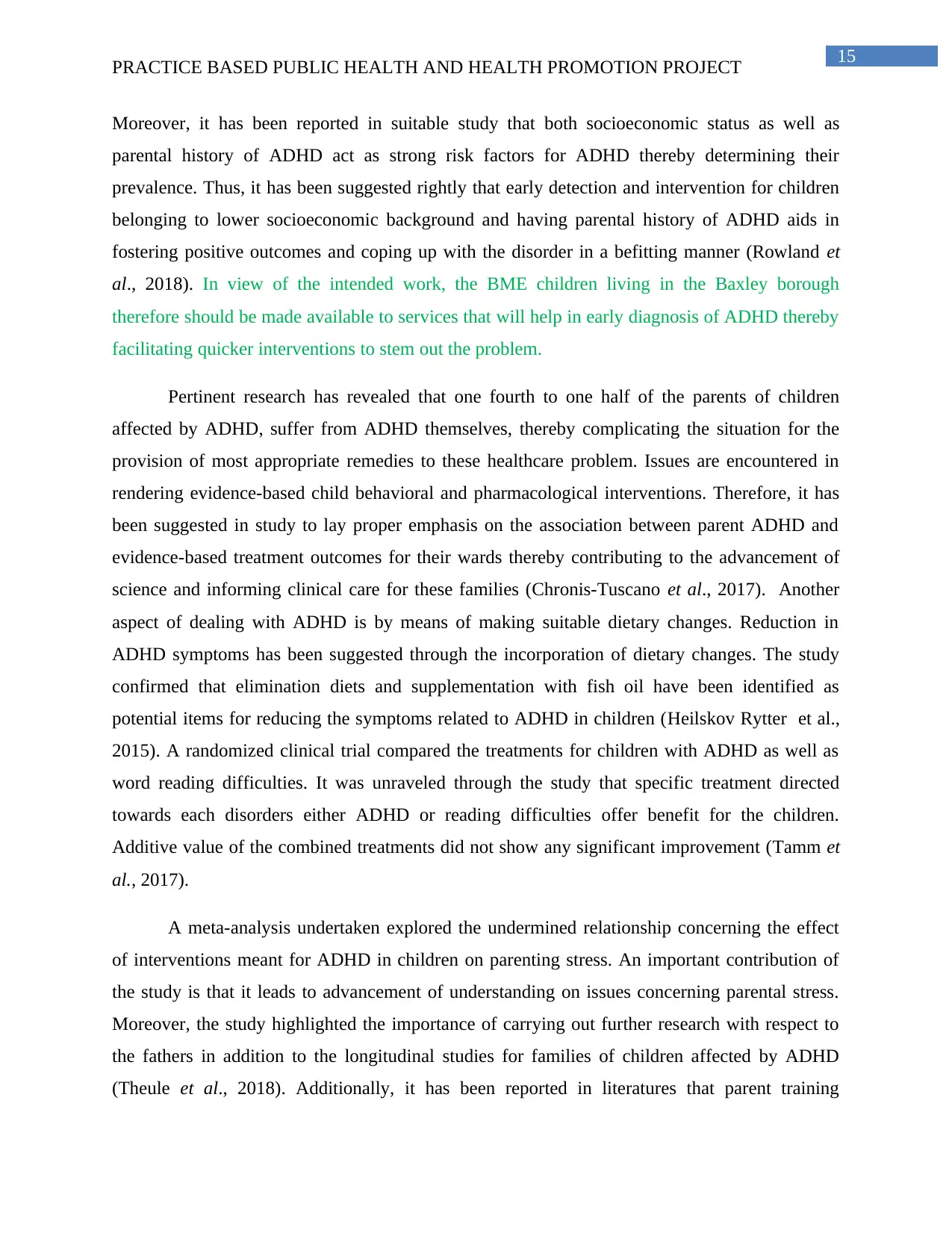
15
PRACTICE BASED PUBLIC HEALTH AND HEALTH PROMOTION PROJECT
Moreover, it has been reported in suitable study that both socioeconomic status as well as
parental history of ADHD act as strong risk factors for ADHD thereby determining their
prevalence. Thus, it has been suggested rightly that early detection and intervention for children
belonging to lower socioeconomic background and having parental history of ADHD aids in
fostering positive outcomes and coping up with the disorder in a befitting manner (Rowland et
al., 2018). In view of the intended work, the BME children living in the Baxley borough
therefore should be made available to services that will help in early diagnosis of ADHD thereby
facilitating quicker interventions to stem out the problem.
Pertinent research has revealed that one fourth to one half of the parents of children
affected by ADHD, suffer from ADHD themselves, thereby complicating the situation for the
provision of most appropriate remedies to these healthcare problem. Issues are encountered in
rendering evidence-based child behavioral and pharmacological interventions. Therefore, it has
been suggested in study to lay proper emphasis on the association between parent ADHD and
evidence-based treatment outcomes for their wards thereby contributing to the advancement of
science and informing clinical care for these families (Chronis-Tuscano et al., 2017). Another
aspect of dealing with ADHD is by means of making suitable dietary changes. Reduction in
ADHD symptoms has been suggested through the incorporation of dietary changes. The study
confirmed that elimination diets and supplementation with fish oil have been identified as
potential items for reducing the symptoms related to ADHD in children (Heilskov Rytter et al.,
2015). A randomized clinical trial compared the treatments for children with ADHD as well as
word reading difficulties. It was unraveled through the study that specific treatment directed
towards each disorders either ADHD or reading difficulties offer benefit for the children.
Additive value of the combined treatments did not show any significant improvement (Tamm et
al., 2017).
A meta-analysis undertaken explored the undermined relationship concerning the effect
of interventions meant for ADHD in children on parenting stress. An important contribution of
the study is that it leads to advancement of understanding on issues concerning parental stress.
Moreover, the study highlighted the importance of carrying out further research with respect to
the fathers in addition to the longitudinal studies for families of children affected by ADHD
(Theule et al., 2018). Additionally, it has been reported in literatures that parent training
PRACTICE BASED PUBLIC HEALTH AND HEALTH PROMOTION PROJECT
Moreover, it has been reported in suitable study that both socioeconomic status as well as
parental history of ADHD act as strong risk factors for ADHD thereby determining their
prevalence. Thus, it has been suggested rightly that early detection and intervention for children
belonging to lower socioeconomic background and having parental history of ADHD aids in
fostering positive outcomes and coping up with the disorder in a befitting manner (Rowland et
al., 2018). In view of the intended work, the BME children living in the Baxley borough
therefore should be made available to services that will help in early diagnosis of ADHD thereby
facilitating quicker interventions to stem out the problem.
Pertinent research has revealed that one fourth to one half of the parents of children
affected by ADHD, suffer from ADHD themselves, thereby complicating the situation for the
provision of most appropriate remedies to these healthcare problem. Issues are encountered in
rendering evidence-based child behavioral and pharmacological interventions. Therefore, it has
been suggested in study to lay proper emphasis on the association between parent ADHD and
evidence-based treatment outcomes for their wards thereby contributing to the advancement of
science and informing clinical care for these families (Chronis-Tuscano et al., 2017). Another
aspect of dealing with ADHD is by means of making suitable dietary changes. Reduction in
ADHD symptoms has been suggested through the incorporation of dietary changes. The study
confirmed that elimination diets and supplementation with fish oil have been identified as
potential items for reducing the symptoms related to ADHD in children (Heilskov Rytter et al.,
2015). A randomized clinical trial compared the treatments for children with ADHD as well as
word reading difficulties. It was unraveled through the study that specific treatment directed
towards each disorders either ADHD or reading difficulties offer benefit for the children.
Additive value of the combined treatments did not show any significant improvement (Tamm et
al., 2017).
A meta-analysis undertaken explored the undermined relationship concerning the effect
of interventions meant for ADHD in children on parenting stress. An important contribution of
the study is that it leads to advancement of understanding on issues concerning parental stress.
Moreover, the study highlighted the importance of carrying out further research with respect to
the fathers in addition to the longitudinal studies for families of children affected by ADHD
(Theule et al., 2018). Additionally, it has been reported in literatures that parent training
Paraphrase This Document
Need a fresh take? Get an instant paraphrase of this document with our AI Paraphraser
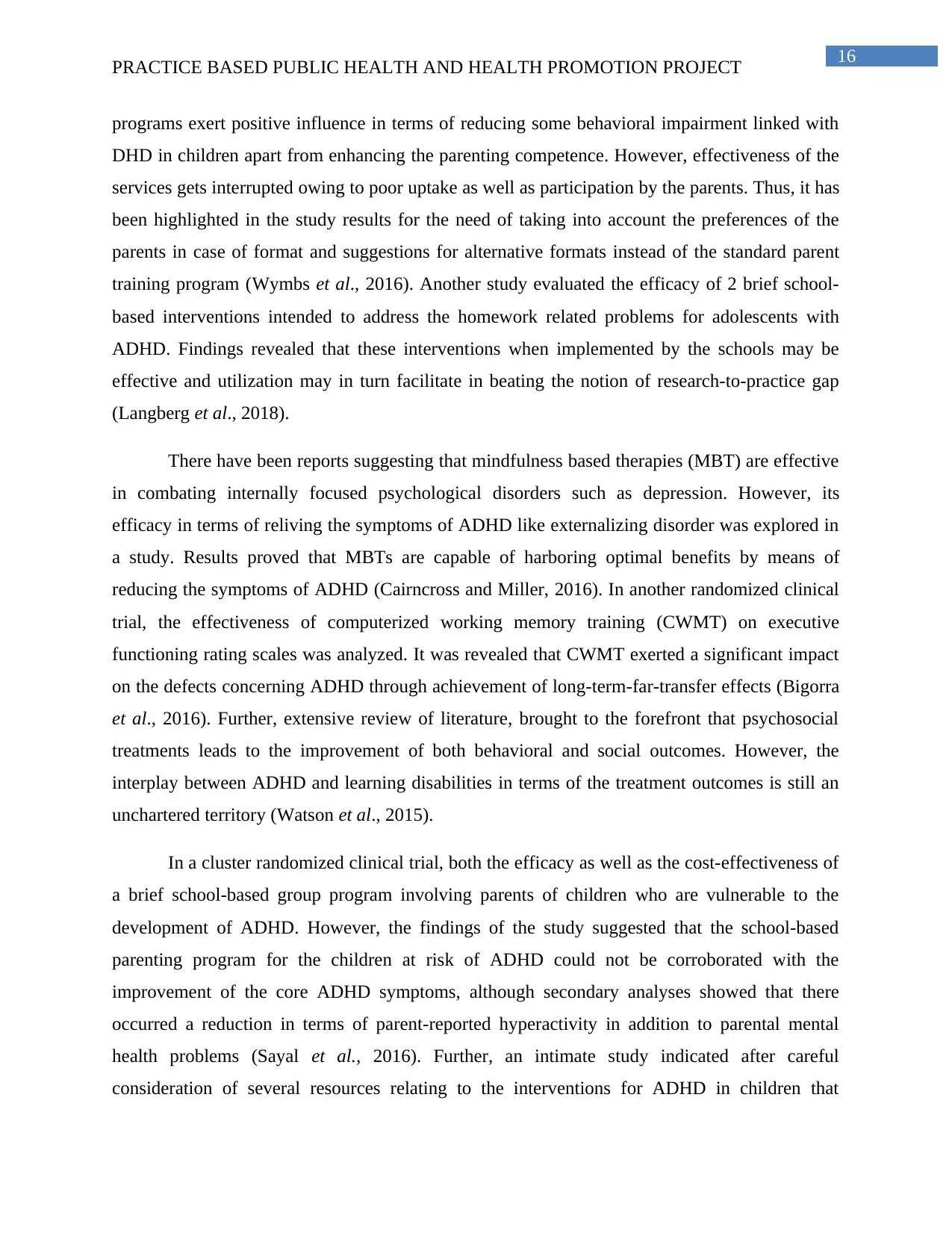
16
PRACTICE BASED PUBLIC HEALTH AND HEALTH PROMOTION PROJECT
programs exert positive influence in terms of reducing some behavioral impairment linked with
DHD in children apart from enhancing the parenting competence. However, effectiveness of the
services gets interrupted owing to poor uptake as well as participation by the parents. Thus, it has
been highlighted in the study results for the need of taking into account the preferences of the
parents in case of format and suggestions for alternative formats instead of the standard parent
training program (Wymbs et al., 2016). Another study evaluated the efficacy of 2 brief school-
based interventions intended to address the homework related problems for adolescents with
ADHD. Findings revealed that these interventions when implemented by the schools may be
effective and utilization may in turn facilitate in beating the notion of research-to-practice gap
(Langberg et al., 2018).
There have been reports suggesting that mindfulness based therapies (MBT) are effective
in combating internally focused psychological disorders such as depression. However, its
efficacy in terms of reliving the symptoms of ADHD like externalizing disorder was explored in
a study. Results proved that MBTs are capable of harboring optimal benefits by means of
reducing the symptoms of ADHD (Cairncross and Miller, 2016). In another randomized clinical
trial, the effectiveness of computerized working memory training (CWMT) on executive
functioning rating scales was analyzed. It was revealed that CWMT exerted a significant impact
on the defects concerning ADHD through achievement of long-term-far-transfer effects (Bigorra
et al., 2016). Further, extensive review of literature, brought to the forefront that psychosocial
treatments leads to the improvement of both behavioral and social outcomes. However, the
interplay between ADHD and learning disabilities in terms of the treatment outcomes is still an
unchartered territory (Watson et al., 2015).
In a cluster randomized clinical trial, both the efficacy as well as the cost-effectiveness of
a brief school-based group program involving parents of children who are vulnerable to the
development of ADHD. However, the findings of the study suggested that the school-based
parenting program for the children at risk of ADHD could not be corroborated with the
improvement of the core ADHD symptoms, although secondary analyses showed that there
occurred a reduction in terms of parent-reported hyperactivity in addition to parental mental
health problems (Sayal et al., 2016). Further, an intimate study indicated after careful
consideration of several resources relating to the interventions for ADHD in children that
PRACTICE BASED PUBLIC HEALTH AND HEALTH PROMOTION PROJECT
programs exert positive influence in terms of reducing some behavioral impairment linked with
DHD in children apart from enhancing the parenting competence. However, effectiveness of the
services gets interrupted owing to poor uptake as well as participation by the parents. Thus, it has
been highlighted in the study results for the need of taking into account the preferences of the
parents in case of format and suggestions for alternative formats instead of the standard parent
training program (Wymbs et al., 2016). Another study evaluated the efficacy of 2 brief school-
based interventions intended to address the homework related problems for adolescents with
ADHD. Findings revealed that these interventions when implemented by the schools may be
effective and utilization may in turn facilitate in beating the notion of research-to-practice gap
(Langberg et al., 2018).
There have been reports suggesting that mindfulness based therapies (MBT) are effective
in combating internally focused psychological disorders such as depression. However, its
efficacy in terms of reliving the symptoms of ADHD like externalizing disorder was explored in
a study. Results proved that MBTs are capable of harboring optimal benefits by means of
reducing the symptoms of ADHD (Cairncross and Miller, 2016). In another randomized clinical
trial, the effectiveness of computerized working memory training (CWMT) on executive
functioning rating scales was analyzed. It was revealed that CWMT exerted a significant impact
on the defects concerning ADHD through achievement of long-term-far-transfer effects (Bigorra
et al., 2016). Further, extensive review of literature, brought to the forefront that psychosocial
treatments leads to the improvement of both behavioral and social outcomes. However, the
interplay between ADHD and learning disabilities in terms of the treatment outcomes is still an
unchartered territory (Watson et al., 2015).
In a cluster randomized clinical trial, both the efficacy as well as the cost-effectiveness of
a brief school-based group program involving parents of children who are vulnerable to the
development of ADHD. However, the findings of the study suggested that the school-based
parenting program for the children at risk of ADHD could not be corroborated with the
improvement of the core ADHD symptoms, although secondary analyses showed that there
occurred a reduction in terms of parent-reported hyperactivity in addition to parental mental
health problems (Sayal et al., 2016). Further, an intimate study indicated after careful
consideration of several resources relating to the interventions for ADHD in children that
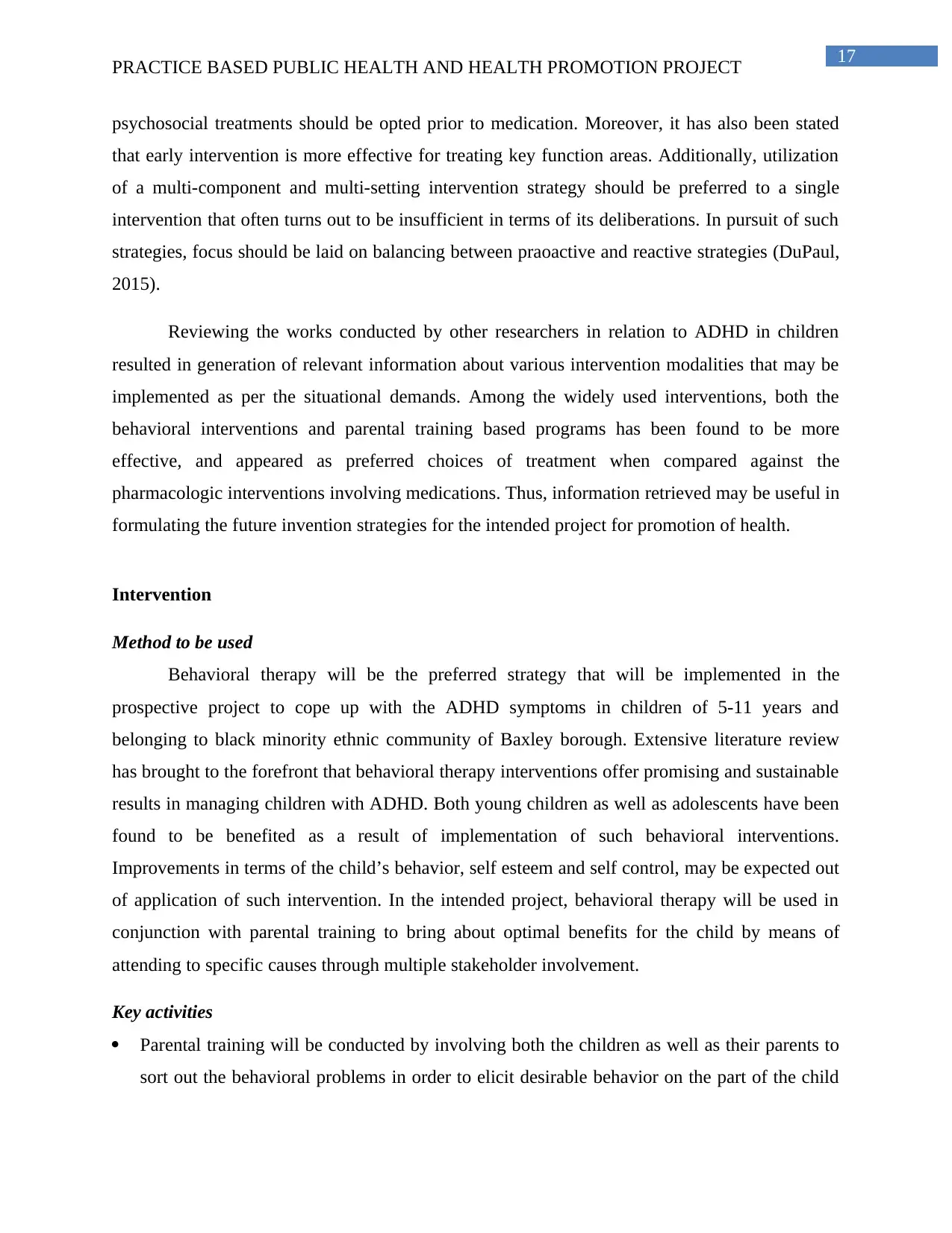
17
PRACTICE BASED PUBLIC HEALTH AND HEALTH PROMOTION PROJECT
psychosocial treatments should be opted prior to medication. Moreover, it has also been stated
that early intervention is more effective for treating key function areas. Additionally, utilization
of a multi-component and multi-setting intervention strategy should be preferred to a single
intervention that often turns out to be insufficient in terms of its deliberations. In pursuit of such
strategies, focus should be laid on balancing between praoactive and reactive strategies (DuPaul,
2015).
Reviewing the works conducted by other researchers in relation to ADHD in children
resulted in generation of relevant information about various intervention modalities that may be
implemented as per the situational demands. Among the widely used interventions, both the
behavioral interventions and parental training based programs has been found to be more
effective, and appeared as preferred choices of treatment when compared against the
pharmacologic interventions involving medications. Thus, information retrieved may be useful in
formulating the future invention strategies for the intended project for promotion of health.
Intervention
Method to be used
Behavioral therapy will be the preferred strategy that will be implemented in the
prospective project to cope up with the ADHD symptoms in children of 5-11 years and
belonging to black minority ethnic community of Baxley borough. Extensive literature review
has brought to the forefront that behavioral therapy interventions offer promising and sustainable
results in managing children with ADHD. Both young children as well as adolescents have been
found to be benefited as a result of implementation of such behavioral interventions.
Improvements in terms of the child’s behavior, self esteem and self control, may be expected out
of application of such intervention. In the intended project, behavioral therapy will be used in
conjunction with parental training to bring about optimal benefits for the child by means of
attending to specific causes through multiple stakeholder involvement.
Key activities
Parental training will be conducted by involving both the children as well as their parents to
sort out the behavioral problems in order to elicit desirable behavior on the part of the child
PRACTICE BASED PUBLIC HEALTH AND HEALTH PROMOTION PROJECT
psychosocial treatments should be opted prior to medication. Moreover, it has also been stated
that early intervention is more effective for treating key function areas. Additionally, utilization
of a multi-component and multi-setting intervention strategy should be preferred to a single
intervention that often turns out to be insufficient in terms of its deliberations. In pursuit of such
strategies, focus should be laid on balancing between praoactive and reactive strategies (DuPaul,
2015).
Reviewing the works conducted by other researchers in relation to ADHD in children
resulted in generation of relevant information about various intervention modalities that may be
implemented as per the situational demands. Among the widely used interventions, both the
behavioral interventions and parental training based programs has been found to be more
effective, and appeared as preferred choices of treatment when compared against the
pharmacologic interventions involving medications. Thus, information retrieved may be useful in
formulating the future invention strategies for the intended project for promotion of health.
Intervention
Method to be used
Behavioral therapy will be the preferred strategy that will be implemented in the
prospective project to cope up with the ADHD symptoms in children of 5-11 years and
belonging to black minority ethnic community of Baxley borough. Extensive literature review
has brought to the forefront that behavioral therapy interventions offer promising and sustainable
results in managing children with ADHD. Both young children as well as adolescents have been
found to be benefited as a result of implementation of such behavioral interventions.
Improvements in terms of the child’s behavior, self esteem and self control, may be expected out
of application of such intervention. In the intended project, behavioral therapy will be used in
conjunction with parental training to bring about optimal benefits for the child by means of
attending to specific causes through multiple stakeholder involvement.
Key activities
Parental training will be conducted by involving both the children as well as their parents to
sort out the behavioral problems in order to elicit desirable behavior on the part of the child
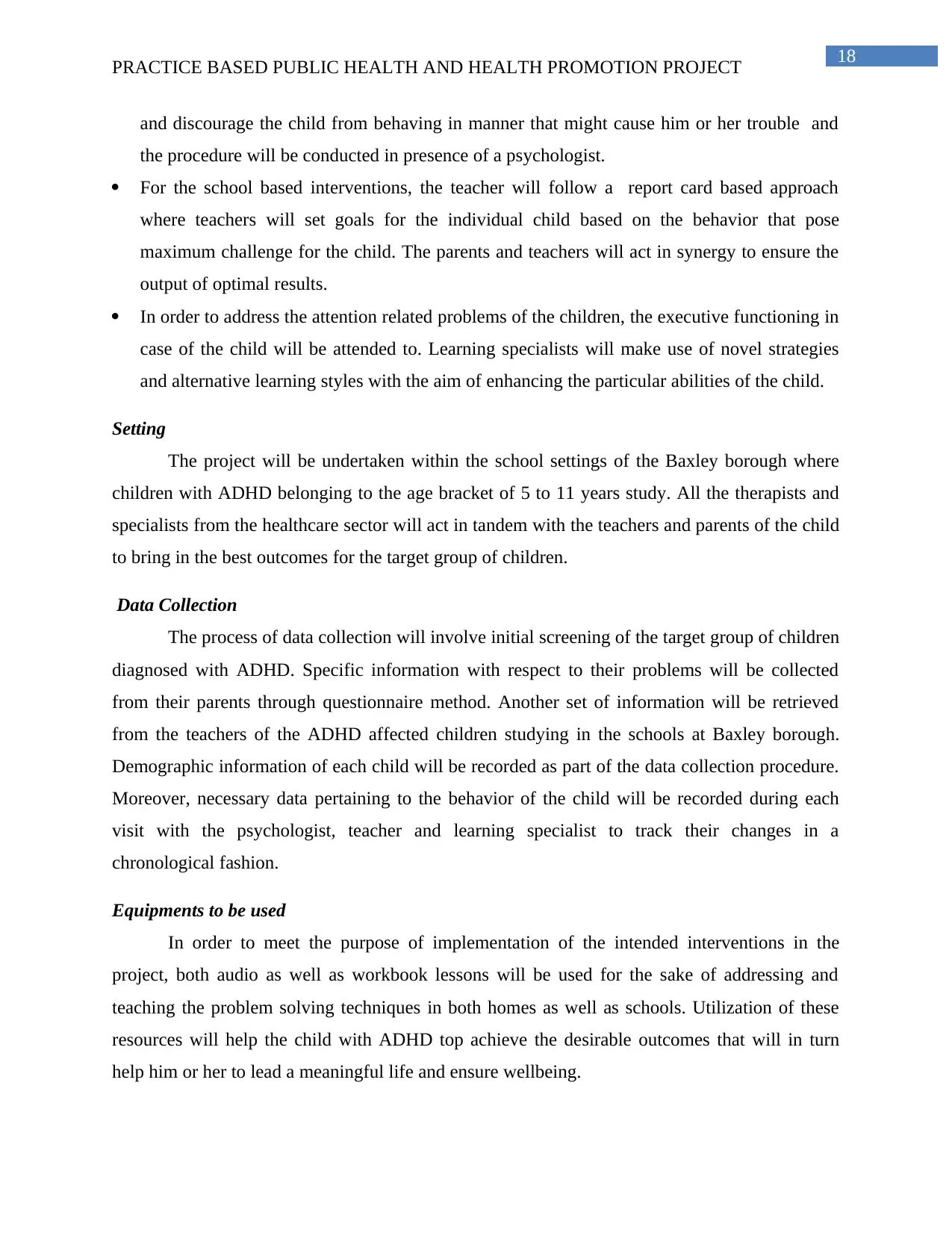
18
PRACTICE BASED PUBLIC HEALTH AND HEALTH PROMOTION PROJECT
and discourage the child from behaving in manner that might cause him or her trouble and
the procedure will be conducted in presence of a psychologist.
For the school based interventions, the teacher will follow a report card based approach
where teachers will set goals for the individual child based on the behavior that pose
maximum challenge for the child. The parents and teachers will act in synergy to ensure the
output of optimal results.
In order to address the attention related problems of the children, the executive functioning in
case of the child will be attended to. Learning specialists will make use of novel strategies
and alternative learning styles with the aim of enhancing the particular abilities of the child.
Setting
The project will be undertaken within the school settings of the Baxley borough where
children with ADHD belonging to the age bracket of 5 to 11 years study. All the therapists and
specialists from the healthcare sector will act in tandem with the teachers and parents of the child
to bring in the best outcomes for the target group of children.
Data Collection
The process of data collection will involve initial screening of the target group of children
diagnosed with ADHD. Specific information with respect to their problems will be collected
from their parents through questionnaire method. Another set of information will be retrieved
from the teachers of the ADHD affected children studying in the schools at Baxley borough.
Demographic information of each child will be recorded as part of the data collection procedure.
Moreover, necessary data pertaining to the behavior of the child will be recorded during each
visit with the psychologist, teacher and learning specialist to track their changes in a
chronological fashion.
Equipments to be used
In order to meet the purpose of implementation of the intended interventions in the
project, both audio as well as workbook lessons will be used for the sake of addressing and
teaching the problem solving techniques in both homes as well as schools. Utilization of these
resources will help the child with ADHD top achieve the desirable outcomes that will in turn
help him or her to lead a meaningful life and ensure wellbeing.
PRACTICE BASED PUBLIC HEALTH AND HEALTH PROMOTION PROJECT
and discourage the child from behaving in manner that might cause him or her trouble and
the procedure will be conducted in presence of a psychologist.
For the school based interventions, the teacher will follow a report card based approach
where teachers will set goals for the individual child based on the behavior that pose
maximum challenge for the child. The parents and teachers will act in synergy to ensure the
output of optimal results.
In order to address the attention related problems of the children, the executive functioning in
case of the child will be attended to. Learning specialists will make use of novel strategies
and alternative learning styles with the aim of enhancing the particular abilities of the child.
Setting
The project will be undertaken within the school settings of the Baxley borough where
children with ADHD belonging to the age bracket of 5 to 11 years study. All the therapists and
specialists from the healthcare sector will act in tandem with the teachers and parents of the child
to bring in the best outcomes for the target group of children.
Data Collection
The process of data collection will involve initial screening of the target group of children
diagnosed with ADHD. Specific information with respect to their problems will be collected
from their parents through questionnaire method. Another set of information will be retrieved
from the teachers of the ADHD affected children studying in the schools at Baxley borough.
Demographic information of each child will be recorded as part of the data collection procedure.
Moreover, necessary data pertaining to the behavior of the child will be recorded during each
visit with the psychologist, teacher and learning specialist to track their changes in a
chronological fashion.
Equipments to be used
In order to meet the purpose of implementation of the intended interventions in the
project, both audio as well as workbook lessons will be used for the sake of addressing and
teaching the problem solving techniques in both homes as well as schools. Utilization of these
resources will help the child with ADHD top achieve the desirable outcomes that will in turn
help him or her to lead a meaningful life and ensure wellbeing.
Secure Best Marks with AI Grader
Need help grading? Try our AI Grader for instant feedback on your assignments.
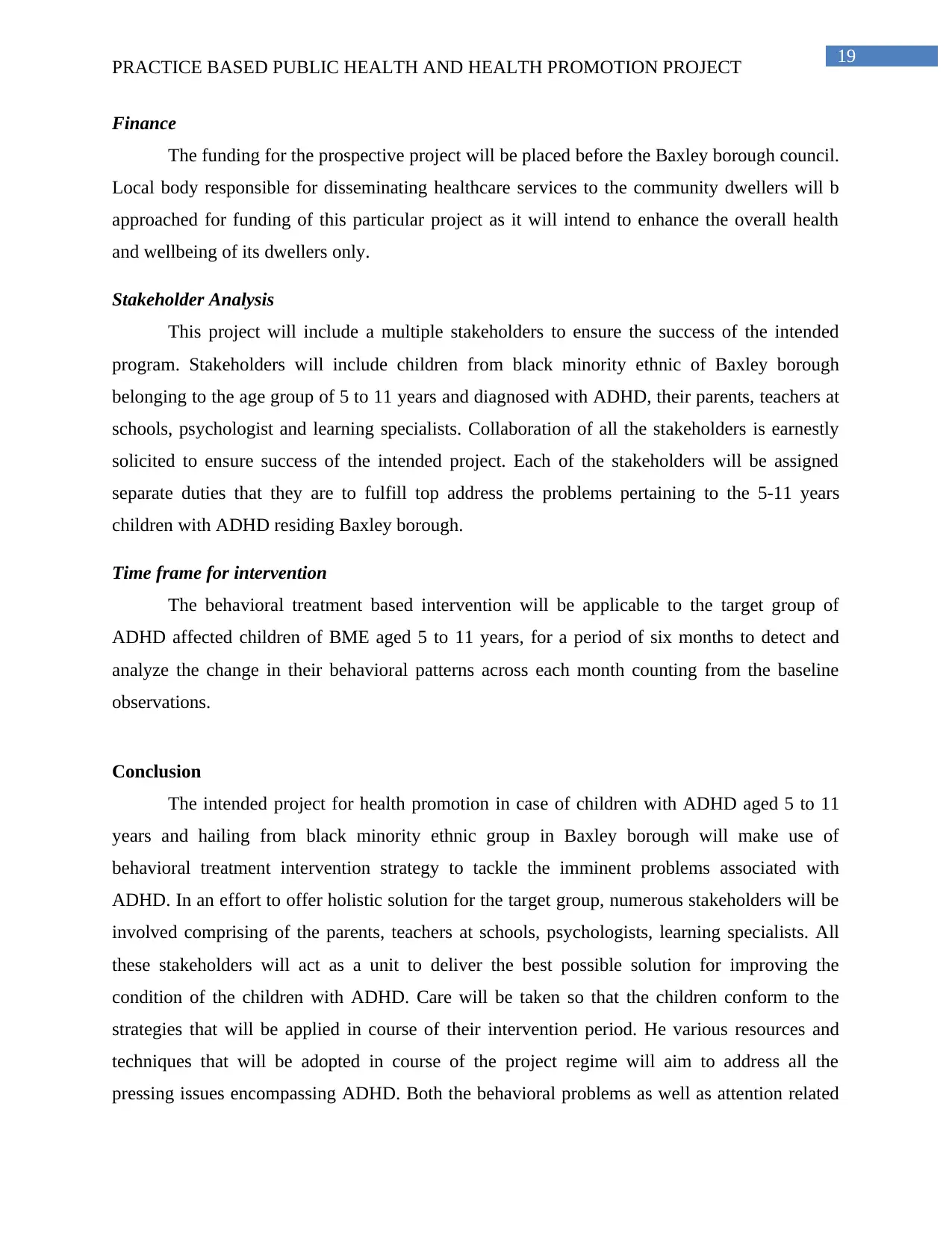
19
PRACTICE BASED PUBLIC HEALTH AND HEALTH PROMOTION PROJECT
Finance
The funding for the prospective project will be placed before the Baxley borough council.
Local body responsible for disseminating healthcare services to the community dwellers will b
approached for funding of this particular project as it will intend to enhance the overall health
and wellbeing of its dwellers only.
Stakeholder Analysis
This project will include a multiple stakeholders to ensure the success of the intended
program. Stakeholders will include children from black minority ethnic of Baxley borough
belonging to the age group of 5 to 11 years and diagnosed with ADHD, their parents, teachers at
schools, psychologist and learning specialists. Collaboration of all the stakeholders is earnestly
solicited to ensure success of the intended project. Each of the stakeholders will be assigned
separate duties that they are to fulfill top address the problems pertaining to the 5-11 years
children with ADHD residing Baxley borough.
Time frame for intervention
The behavioral treatment based intervention will be applicable to the target group of
ADHD affected children of BME aged 5 to 11 years, for a period of six months to detect and
analyze the change in their behavioral patterns across each month counting from the baseline
observations.
Conclusion
The intended project for health promotion in case of children with ADHD aged 5 to 11
years and hailing from black minority ethnic group in Baxley borough will make use of
behavioral treatment intervention strategy to tackle the imminent problems associated with
ADHD. In an effort to offer holistic solution for the target group, numerous stakeholders will be
involved comprising of the parents, teachers at schools, psychologists, learning specialists. All
these stakeholders will act as a unit to deliver the best possible solution for improving the
condition of the children with ADHD. Care will be taken so that the children conform to the
strategies that will be applied in course of their intervention period. He various resources and
techniques that will be adopted in course of the project regime will aim to address all the
pressing issues encompassing ADHD. Both the behavioral problems as well as attention related
PRACTICE BASED PUBLIC HEALTH AND HEALTH PROMOTION PROJECT
Finance
The funding for the prospective project will be placed before the Baxley borough council.
Local body responsible for disseminating healthcare services to the community dwellers will b
approached for funding of this particular project as it will intend to enhance the overall health
and wellbeing of its dwellers only.
Stakeholder Analysis
This project will include a multiple stakeholders to ensure the success of the intended
program. Stakeholders will include children from black minority ethnic of Baxley borough
belonging to the age group of 5 to 11 years and diagnosed with ADHD, their parents, teachers at
schools, psychologist and learning specialists. Collaboration of all the stakeholders is earnestly
solicited to ensure success of the intended project. Each of the stakeholders will be assigned
separate duties that they are to fulfill top address the problems pertaining to the 5-11 years
children with ADHD residing Baxley borough.
Time frame for intervention
The behavioral treatment based intervention will be applicable to the target group of
ADHD affected children of BME aged 5 to 11 years, for a period of six months to detect and
analyze the change in their behavioral patterns across each month counting from the baseline
observations.
Conclusion
The intended project for health promotion in case of children with ADHD aged 5 to 11
years and hailing from black minority ethnic group in Baxley borough will make use of
behavioral treatment intervention strategy to tackle the imminent problems associated with
ADHD. In an effort to offer holistic solution for the target group, numerous stakeholders will be
involved comprising of the parents, teachers at schools, psychologists, learning specialists. All
these stakeholders will act as a unit to deliver the best possible solution for improving the
condition of the children with ADHD. Care will be taken so that the children conform to the
strategies that will be applied in course of their intervention period. He various resources and
techniques that will be adopted in course of the project regime will aim to address all the
pressing issues encompassing ADHD. Both the behavioral problems as well as attention related

20
PRACTICE BASED PUBLIC HEALTH AND HEALTH PROMOTION PROJECT
problems will be addressed through appropriate avenues whereby overall enhancement of the
self-esteem and self-activity related skills of the intended group would be ensured. The children
at the end of the intervention period will be is a position to align themselves with the normal
mode of life surpassing all the challenges due to social determinants of health.
PRACTICE BASED PUBLIC HEALTH AND HEALTH PROMOTION PROJECT
problems will be addressed through appropriate avenues whereby overall enhancement of the
self-esteem and self-activity related skills of the intended group would be ensured. The children
at the end of the intervention period will be is a position to align themselves with the normal
mode of life surpassing all the challenges due to social determinants of health.
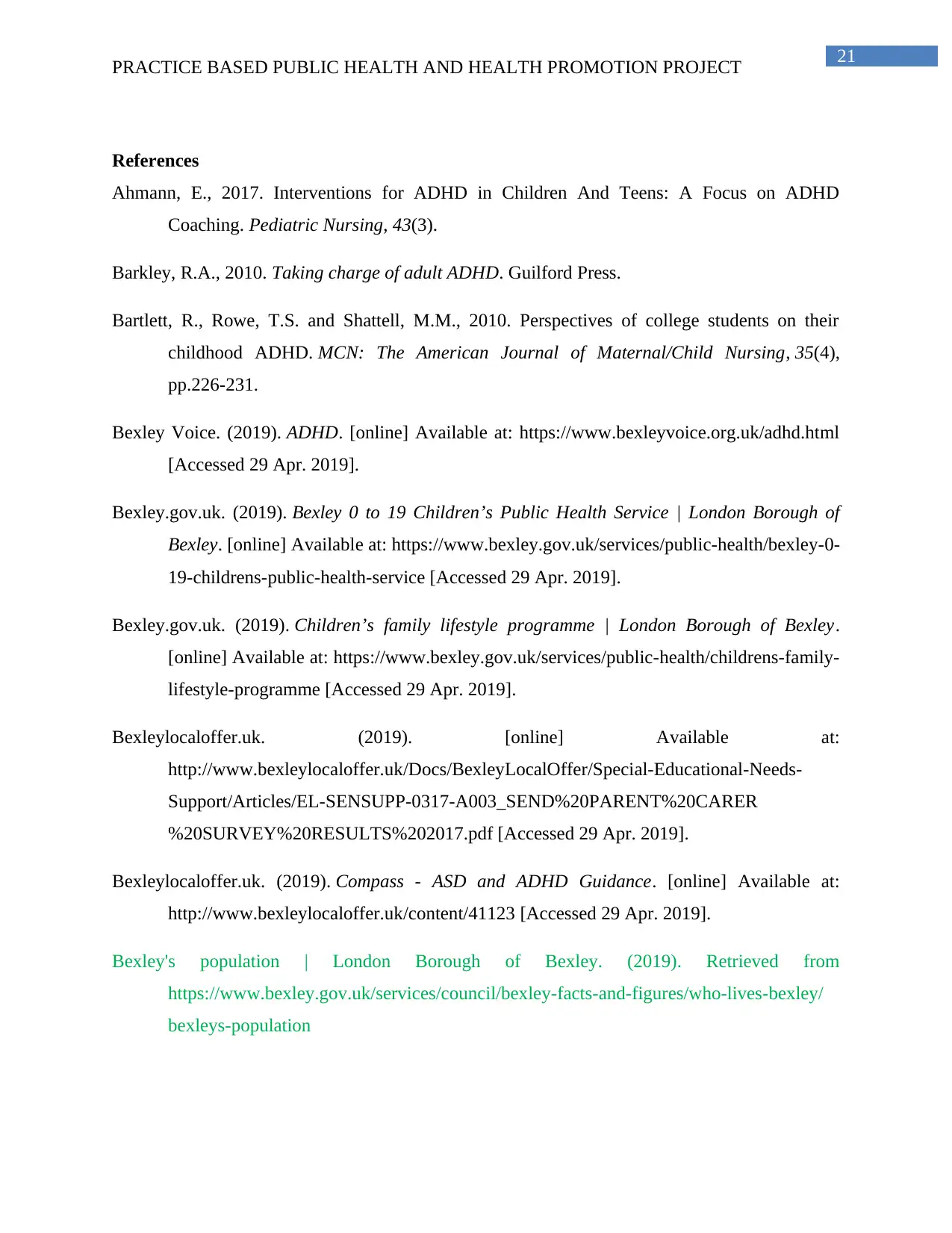
21
PRACTICE BASED PUBLIC HEALTH AND HEALTH PROMOTION PROJECT
References
Ahmann, E., 2017. Interventions for ADHD in Children And Teens: A Focus on ADHD
Coaching. Pediatric Nursing, 43(3).
Barkley, R.A., 2010. Taking charge of adult ADHD. Guilford Press.
Bartlett, R., Rowe, T.S. and Shattell, M.M., 2010. Perspectives of college students on their
childhood ADHD. MCN: The American Journal of Maternal/Child Nursing, 35(4),
pp.226-231.
Bexley Voice. (2019). ADHD. [online] Available at: https://www.bexleyvoice.org.uk/adhd.html
[Accessed 29 Apr. 2019].
Bexley.gov.uk. (2019). Bexley 0 to 19 Children’s Public Health Service | London Borough of
Bexley. [online] Available at: https://www.bexley.gov.uk/services/public-health/bexley-0-
19-childrens-public-health-service [Accessed 29 Apr. 2019].
Bexley.gov.uk. (2019). Children’s family lifestyle programme | London Borough of Bexley.
[online] Available at: https://www.bexley.gov.uk/services/public-health/childrens-family-
lifestyle-programme [Accessed 29 Apr. 2019].
Bexleylocaloffer.uk. (2019). [online] Available at:
http://www.bexleylocaloffer.uk/Docs/BexleyLocalOffer/Special-Educational-Needs-
Support/Articles/EL-SENSUPP-0317-A003_SEND%20PARENT%20CARER
%20SURVEY%20RESULTS%202017.pdf [Accessed 29 Apr. 2019].
Bexleylocaloffer.uk. (2019). Compass - ASD and ADHD Guidance. [online] Available at:
http://www.bexleylocaloffer.uk/content/41123 [Accessed 29 Apr. 2019].
Bexley's population | London Borough of Bexley. (2019). Retrieved from
https://www.bexley.gov.uk/services/council/bexley-facts-and-figures/who-lives-bexley/
bexleys-population
PRACTICE BASED PUBLIC HEALTH AND HEALTH PROMOTION PROJECT
References
Ahmann, E., 2017. Interventions for ADHD in Children And Teens: A Focus on ADHD
Coaching. Pediatric Nursing, 43(3).
Barkley, R.A., 2010. Taking charge of adult ADHD. Guilford Press.
Bartlett, R., Rowe, T.S. and Shattell, M.M., 2010. Perspectives of college students on their
childhood ADHD. MCN: The American Journal of Maternal/Child Nursing, 35(4),
pp.226-231.
Bexley Voice. (2019). ADHD. [online] Available at: https://www.bexleyvoice.org.uk/adhd.html
[Accessed 29 Apr. 2019].
Bexley.gov.uk. (2019). Bexley 0 to 19 Children’s Public Health Service | London Borough of
Bexley. [online] Available at: https://www.bexley.gov.uk/services/public-health/bexley-0-
19-childrens-public-health-service [Accessed 29 Apr. 2019].
Bexley.gov.uk. (2019). Children’s family lifestyle programme | London Borough of Bexley.
[online] Available at: https://www.bexley.gov.uk/services/public-health/childrens-family-
lifestyle-programme [Accessed 29 Apr. 2019].
Bexleylocaloffer.uk. (2019). [online] Available at:
http://www.bexleylocaloffer.uk/Docs/BexleyLocalOffer/Special-Educational-Needs-
Support/Articles/EL-SENSUPP-0317-A003_SEND%20PARENT%20CARER
%20SURVEY%20RESULTS%202017.pdf [Accessed 29 Apr. 2019].
Bexleylocaloffer.uk. (2019). Compass - ASD and ADHD Guidance. [online] Available at:
http://www.bexleylocaloffer.uk/content/41123 [Accessed 29 Apr. 2019].
Bexley's population | London Borough of Bexley. (2019). Retrieved from
https://www.bexley.gov.uk/services/council/bexley-facts-and-figures/who-lives-bexley/
bexleys-population
Paraphrase This Document
Need a fresh take? Get an instant paraphrase of this document with our AI Paraphraser
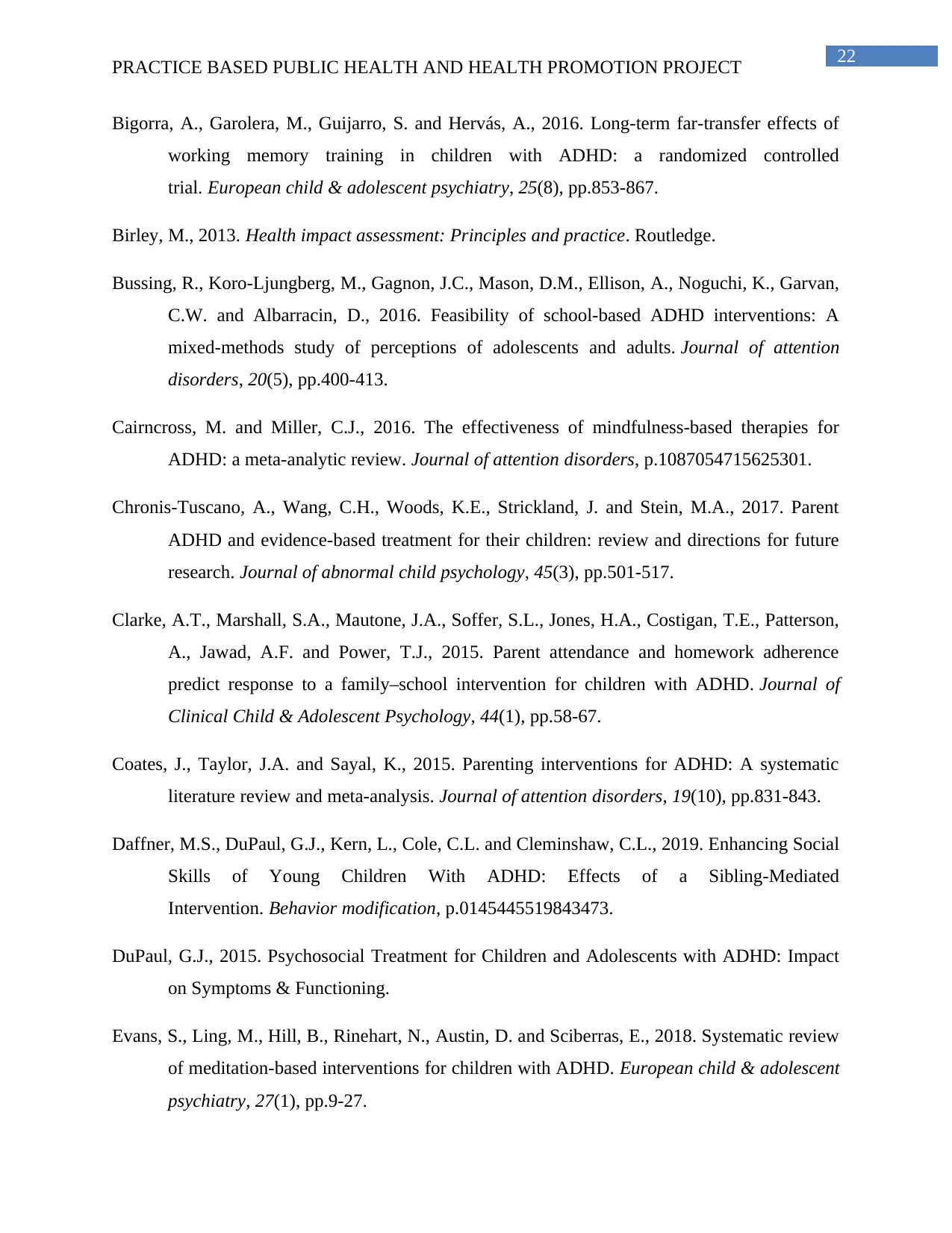
22
PRACTICE BASED PUBLIC HEALTH AND HEALTH PROMOTION PROJECT
Bigorra, A., Garolera, M., Guijarro, S. and Hervás, A., 2016. Long-term far-transfer effects of
working memory training in children with ADHD: a randomized controlled
trial. European child & adolescent psychiatry, 25(8), pp.853-867.
Birley, M., 2013. Health impact assessment: Principles and practice. Routledge.
Bussing, R., Koro-Ljungberg, M., Gagnon, J.C., Mason, D.M., Ellison, A., Noguchi, K., Garvan,
C.W. and Albarracin, D., 2016. Feasibility of school-based ADHD interventions: A
mixed-methods study of perceptions of adolescents and adults. Journal of attention
disorders, 20(5), pp.400-413.
Cairncross, M. and Miller, C.J., 2016. The effectiveness of mindfulness-based therapies for
ADHD: a meta-analytic review. Journal of attention disorders, p.1087054715625301.
Chronis-Tuscano, A., Wang, C.H., Woods, K.E., Strickland, J. and Stein, M.A., 2017. Parent
ADHD and evidence-based treatment for their children: review and directions for future
research. Journal of abnormal child psychology, 45(3), pp.501-517.
Clarke, A.T., Marshall, S.A., Mautone, J.A., Soffer, S.L., Jones, H.A., Costigan, T.E., Patterson,
A., Jawad, A.F. and Power, T.J., 2015. Parent attendance and homework adherence
predict response to a family–school intervention for children with ADHD. Journal of
Clinical Child & Adolescent Psychology, 44(1), pp.58-67.
Coates, J., Taylor, J.A. and Sayal, K., 2015. Parenting interventions for ADHD: A systematic
literature review and meta-analysis. Journal of attention disorders, 19(10), pp.831-843.
Daffner, M.S., DuPaul, G.J., Kern, L., Cole, C.L. and Cleminshaw, C.L., 2019. Enhancing Social
Skills of Young Children With ADHD: Effects of a Sibling-Mediated
Intervention. Behavior modification, p.0145445519843473.
DuPaul, G.J., 2015. Psychosocial Treatment for Children and Adolescents with ADHD: Impact
on Symptoms & Functioning.
Evans, S., Ling, M., Hill, B., Rinehart, N., Austin, D. and Sciberras, E., 2018. Systematic review
of meditation-based interventions for children with ADHD. European child & adolescent
psychiatry, 27(1), pp.9-27.
PRACTICE BASED PUBLIC HEALTH AND HEALTH PROMOTION PROJECT
Bigorra, A., Garolera, M., Guijarro, S. and Hervás, A., 2016. Long-term far-transfer effects of
working memory training in children with ADHD: a randomized controlled
trial. European child & adolescent psychiatry, 25(8), pp.853-867.
Birley, M., 2013. Health impact assessment: Principles and practice. Routledge.
Bussing, R., Koro-Ljungberg, M., Gagnon, J.C., Mason, D.M., Ellison, A., Noguchi, K., Garvan,
C.W. and Albarracin, D., 2016. Feasibility of school-based ADHD interventions: A
mixed-methods study of perceptions of adolescents and adults. Journal of attention
disorders, 20(5), pp.400-413.
Cairncross, M. and Miller, C.J., 2016. The effectiveness of mindfulness-based therapies for
ADHD: a meta-analytic review. Journal of attention disorders, p.1087054715625301.
Chronis-Tuscano, A., Wang, C.H., Woods, K.E., Strickland, J. and Stein, M.A., 2017. Parent
ADHD and evidence-based treatment for their children: review and directions for future
research. Journal of abnormal child psychology, 45(3), pp.501-517.
Clarke, A.T., Marshall, S.A., Mautone, J.A., Soffer, S.L., Jones, H.A., Costigan, T.E., Patterson,
A., Jawad, A.F. and Power, T.J., 2015. Parent attendance and homework adherence
predict response to a family–school intervention for children with ADHD. Journal of
Clinical Child & Adolescent Psychology, 44(1), pp.58-67.
Coates, J., Taylor, J.A. and Sayal, K., 2015. Parenting interventions for ADHD: A systematic
literature review and meta-analysis. Journal of attention disorders, 19(10), pp.831-843.
Daffner, M.S., DuPaul, G.J., Kern, L., Cole, C.L. and Cleminshaw, C.L., 2019. Enhancing Social
Skills of Young Children With ADHD: Effects of a Sibling-Mediated
Intervention. Behavior modification, p.0145445519843473.
DuPaul, G.J., 2015. Psychosocial Treatment for Children and Adolescents with ADHD: Impact
on Symptoms & Functioning.
Evans, S., Ling, M., Hill, B., Rinehart, N., Austin, D. and Sciberras, E., 2018. Systematic review
of meditation-based interventions for children with ADHD. European child & adolescent
psychiatry, 27(1), pp.9-27.

23
PRACTICE BASED PUBLIC HEALTH AND HEALTH PROMOTION PROJECT
Forehand, R., Parent, J., Peisch, V.D., Sonuga-Barke, E., Long, N., Breslend, N.L. and Abikoff,
H.B., 2017. Do parental ADHD symptoms reduce the efficacy of parent training for
preschool ADHD? A secondary analysis of a randomized controlled trial. Behaviour
research and therapy, 97, pp.163-169.
Gawrilow, C., Stadler, G., Langguth, N., Naumann, A. and Boeck, A., 2016. Physical activity,
affect, and cognition in children with symptoms of ADHD. Journal of attention
disorders, 20(2), pp.151-162.
Gilead, T., 2019. Promoting Distributive Justice in Education and the Challenge of
Unpredictability. Studies in Philosophy and Education, pp.1-13.
Heilskov Rytter, M.J., Andersen, L.B.B., Houmann, T., Bilenberg, N., Hvolby, A., Mølgaard, C.,
Michaelsen, K.F. and Lauritzen, L., 2015. Diet in the treatment of ADHD in children—a
systematic review of the literature. Nordic Journal of Psychiatry, 69(1), pp.1-18.
Horton-Salway, M. (2011). Repertoires of ADHD in UK newspaper media. Health:, 15(5), 533-
549.
Langberg, J.M., Dvorsky, M.R., Molitor, S.J., Bourchtein, E., Eddy, L.D., Smith, Z.R., Oddo,
L.E. and Eadeh, H.M., 2018. Overcoming the research-to-practice gap: A randomized
trial with two brief homework and organization interventions for students with ADHD as
implemented by school mental health providers. Journal of consulting and clinical
psychology, 86(1), p.39.
Li, J.J. and Lansford, J.E., 2018. A smartphone-based ecological momentary assessment of
parental behavioral consistency: Associations with parental stress and child ADHD
symptoms. Developmental psychology.
Localstats.co.uk. (2019). Bexley Census Demographics United Kingdom. [online] Available at:
http://localstats.co.uk/census-demographics/england/london/bexley [Accessed 29 Apr.
2019].
Loe, I.M. and Feldman, H.M., 2007. Academic and educational outcomes of children with
ADHD. Journal of pediatric psychology, 32(6), pp.643-654.
PRACTICE BASED PUBLIC HEALTH AND HEALTH PROMOTION PROJECT
Forehand, R., Parent, J., Peisch, V.D., Sonuga-Barke, E., Long, N., Breslend, N.L. and Abikoff,
H.B., 2017. Do parental ADHD symptoms reduce the efficacy of parent training for
preschool ADHD? A secondary analysis of a randomized controlled trial. Behaviour
research and therapy, 97, pp.163-169.
Gawrilow, C., Stadler, G., Langguth, N., Naumann, A. and Boeck, A., 2016. Physical activity,
affect, and cognition in children with symptoms of ADHD. Journal of attention
disorders, 20(2), pp.151-162.
Gilead, T., 2019. Promoting Distributive Justice in Education and the Challenge of
Unpredictability. Studies in Philosophy and Education, pp.1-13.
Heilskov Rytter, M.J., Andersen, L.B.B., Houmann, T., Bilenberg, N., Hvolby, A., Mølgaard, C.,
Michaelsen, K.F. and Lauritzen, L., 2015. Diet in the treatment of ADHD in children—a
systematic review of the literature. Nordic Journal of Psychiatry, 69(1), pp.1-18.
Horton-Salway, M. (2011). Repertoires of ADHD in UK newspaper media. Health:, 15(5), 533-
549.
Langberg, J.M., Dvorsky, M.R., Molitor, S.J., Bourchtein, E., Eddy, L.D., Smith, Z.R., Oddo,
L.E. and Eadeh, H.M., 2018. Overcoming the research-to-practice gap: A randomized
trial with two brief homework and organization interventions for students with ADHD as
implemented by school mental health providers. Journal of consulting and clinical
psychology, 86(1), p.39.
Li, J.J. and Lansford, J.E., 2018. A smartphone-based ecological momentary assessment of
parental behavioral consistency: Associations with parental stress and child ADHD
symptoms. Developmental psychology.
Localstats.co.uk. (2019). Bexley Census Demographics United Kingdom. [online] Available at:
http://localstats.co.uk/census-demographics/england/london/bexley [Accessed 29 Apr.
2019].
Loe, I.M. and Feldman, H.M., 2007. Academic and educational outcomes of children with
ADHD. Journal of pediatric psychology, 32(6), pp.643-654.
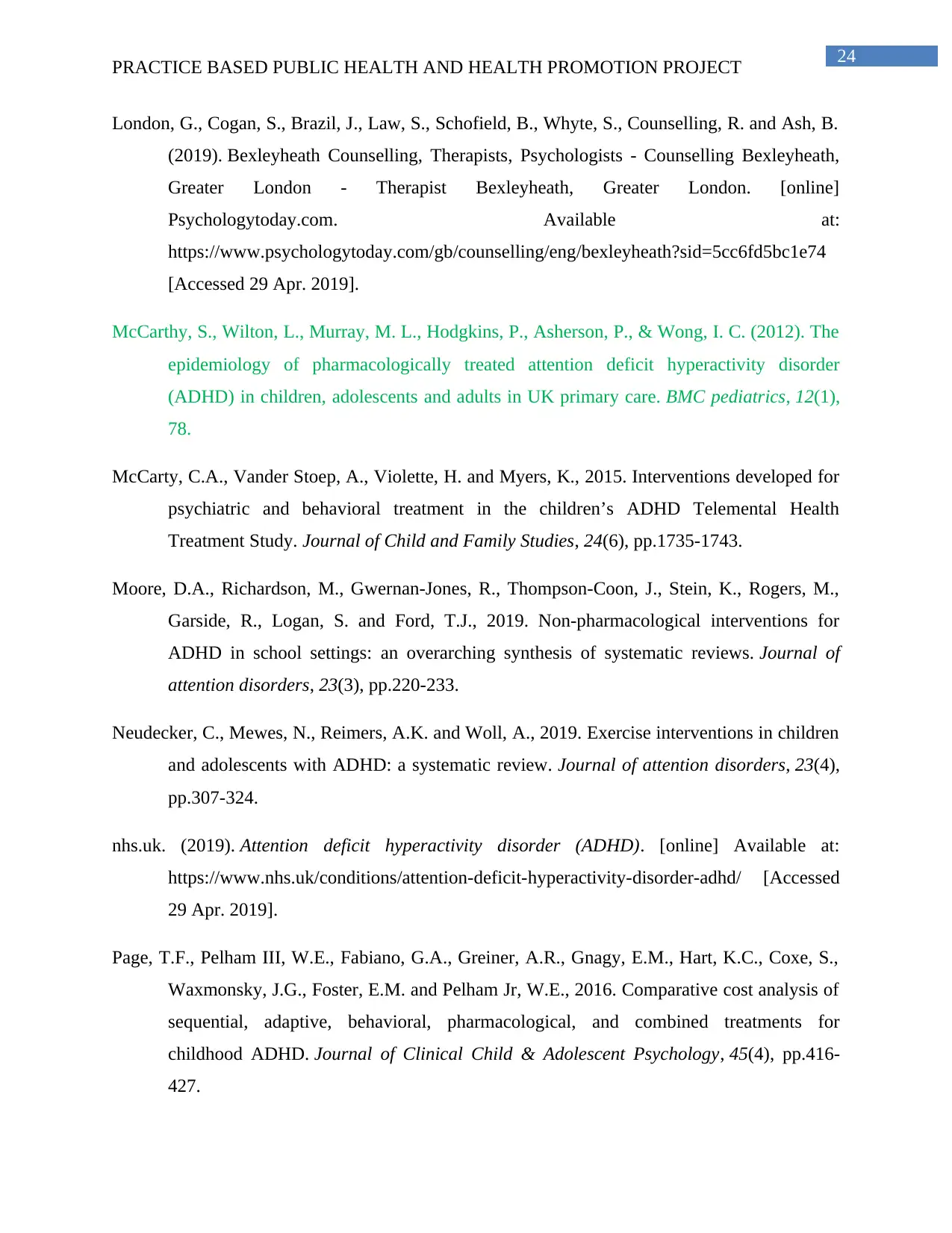
24
PRACTICE BASED PUBLIC HEALTH AND HEALTH PROMOTION PROJECT
London, G., Cogan, S., Brazil, J., Law, S., Schofield, B., Whyte, S., Counselling, R. and Ash, B.
(2019). Bexleyheath Counselling, Therapists, Psychologists - Counselling Bexleyheath,
Greater London - Therapist Bexleyheath, Greater London. [online]
Psychologytoday.com. Available at:
https://www.psychologytoday.com/gb/counselling/eng/bexleyheath?sid=5cc6fd5bc1e74
[Accessed 29 Apr. 2019].
McCarthy, S., Wilton, L., Murray, M. L., Hodgkins, P., Asherson, P., & Wong, I. C. (2012). The
epidemiology of pharmacologically treated attention deficit hyperactivity disorder
(ADHD) in children, adolescents and adults in UK primary care. BMC pediatrics, 12(1),
78.
McCarty, C.A., Vander Stoep, A., Violette, H. and Myers, K., 2015. Interventions developed for
psychiatric and behavioral treatment in the children’s ADHD Telemental Health
Treatment Study. Journal of Child and Family Studies, 24(6), pp.1735-1743.
Moore, D.A., Richardson, M., Gwernan-Jones, R., Thompson-Coon, J., Stein, K., Rogers, M.,
Garside, R., Logan, S. and Ford, T.J., 2019. Non-pharmacological interventions for
ADHD in school settings: an overarching synthesis of systematic reviews. Journal of
attention disorders, 23(3), pp.220-233.
Neudecker, C., Mewes, N., Reimers, A.K. and Woll, A., 2019. Exercise interventions in children
and adolescents with ADHD: a systematic review. Journal of attention disorders, 23(4),
pp.307-324.
nhs.uk. (2019). Attention deficit hyperactivity disorder (ADHD). [online] Available at:
https://www.nhs.uk/conditions/attention-deficit-hyperactivity-disorder-adhd/ [Accessed
29 Apr. 2019].
Page, T.F., Pelham III, W.E., Fabiano, G.A., Greiner, A.R., Gnagy, E.M., Hart, K.C., Coxe, S.,
Waxmonsky, J.G., Foster, E.M. and Pelham Jr, W.E., 2016. Comparative cost analysis of
sequential, adaptive, behavioral, pharmacological, and combined treatments for
childhood ADHD. Journal of Clinical Child & Adolescent Psychology, 45(4), pp.416-
427.
PRACTICE BASED PUBLIC HEALTH AND HEALTH PROMOTION PROJECT
London, G., Cogan, S., Brazil, J., Law, S., Schofield, B., Whyte, S., Counselling, R. and Ash, B.
(2019). Bexleyheath Counselling, Therapists, Psychologists - Counselling Bexleyheath,
Greater London - Therapist Bexleyheath, Greater London. [online]
Psychologytoday.com. Available at:
https://www.psychologytoday.com/gb/counselling/eng/bexleyheath?sid=5cc6fd5bc1e74
[Accessed 29 Apr. 2019].
McCarthy, S., Wilton, L., Murray, M. L., Hodgkins, P., Asherson, P., & Wong, I. C. (2012). The
epidemiology of pharmacologically treated attention deficit hyperactivity disorder
(ADHD) in children, adolescents and adults in UK primary care. BMC pediatrics, 12(1),
78.
McCarty, C.A., Vander Stoep, A., Violette, H. and Myers, K., 2015. Interventions developed for
psychiatric and behavioral treatment in the children’s ADHD Telemental Health
Treatment Study. Journal of Child and Family Studies, 24(6), pp.1735-1743.
Moore, D.A., Richardson, M., Gwernan-Jones, R., Thompson-Coon, J., Stein, K., Rogers, M.,
Garside, R., Logan, S. and Ford, T.J., 2019. Non-pharmacological interventions for
ADHD in school settings: an overarching synthesis of systematic reviews. Journal of
attention disorders, 23(3), pp.220-233.
Neudecker, C., Mewes, N., Reimers, A.K. and Woll, A., 2019. Exercise interventions in children
and adolescents with ADHD: a systematic review. Journal of attention disorders, 23(4),
pp.307-324.
nhs.uk. (2019). Attention deficit hyperactivity disorder (ADHD). [online] Available at:
https://www.nhs.uk/conditions/attention-deficit-hyperactivity-disorder-adhd/ [Accessed
29 Apr. 2019].
Page, T.F., Pelham III, W.E., Fabiano, G.A., Greiner, A.R., Gnagy, E.M., Hart, K.C., Coxe, S.,
Waxmonsky, J.G., Foster, E.M. and Pelham Jr, W.E., 2016. Comparative cost analysis of
sequential, adaptive, behavioral, pharmacological, and combined treatments for
childhood ADHD. Journal of Clinical Child & Adolescent Psychology, 45(4), pp.416-
427.
Secure Best Marks with AI Grader
Need help grading? Try our AI Grader for instant feedback on your assignments.
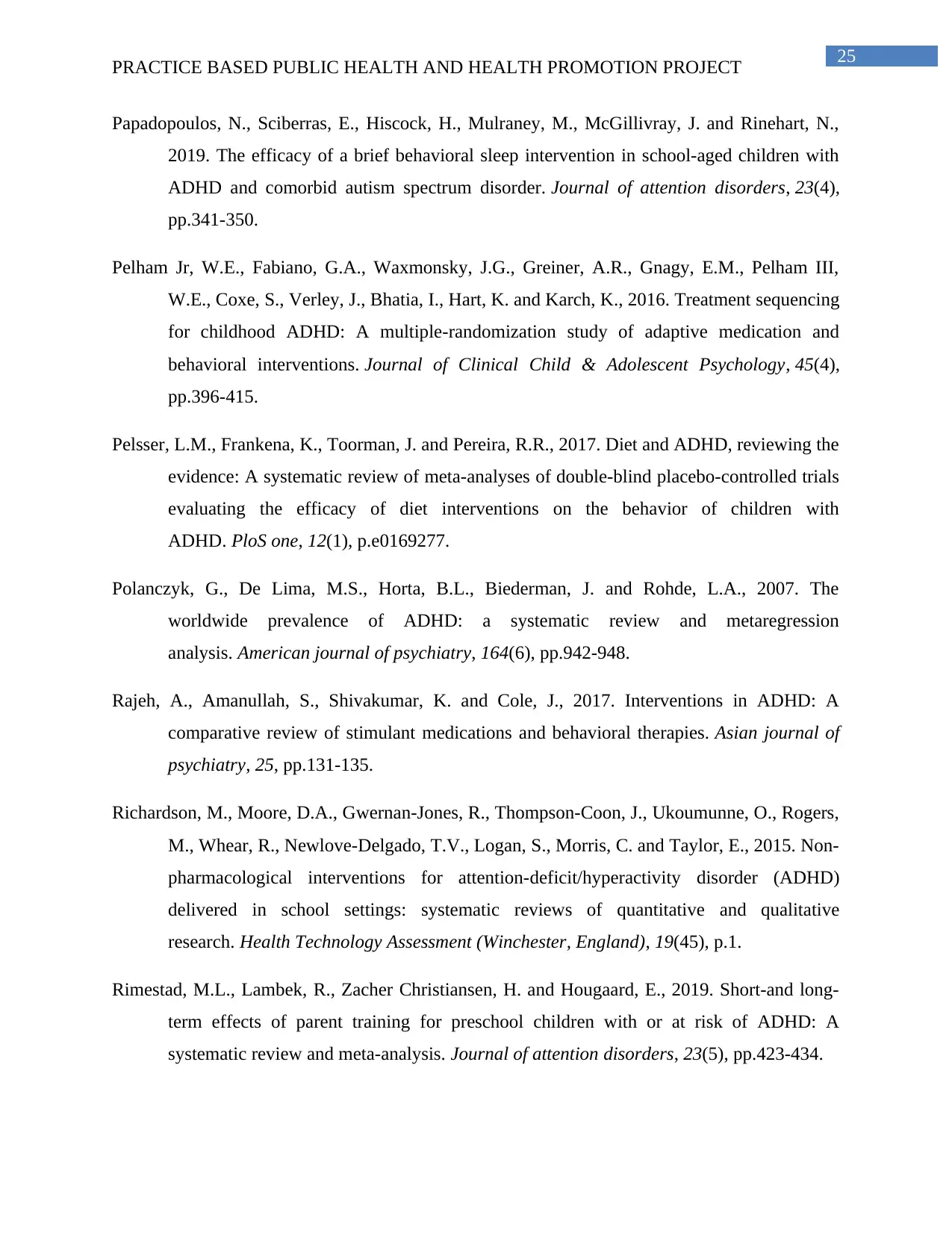
25
PRACTICE BASED PUBLIC HEALTH AND HEALTH PROMOTION PROJECT
Papadopoulos, N., Sciberras, E., Hiscock, H., Mulraney, M., McGillivray, J. and Rinehart, N.,
2019. The efficacy of a brief behavioral sleep intervention in school-aged children with
ADHD and comorbid autism spectrum disorder. Journal of attention disorders, 23(4),
pp.341-350.
Pelham Jr, W.E., Fabiano, G.A., Waxmonsky, J.G., Greiner, A.R., Gnagy, E.M., Pelham III,
W.E., Coxe, S., Verley, J., Bhatia, I., Hart, K. and Karch, K., 2016. Treatment sequencing
for childhood ADHD: A multiple-randomization study of adaptive medication and
behavioral interventions. Journal of Clinical Child & Adolescent Psychology, 45(4),
pp.396-415.
Pelsser, L.M., Frankena, K., Toorman, J. and Pereira, R.R., 2017. Diet and ADHD, reviewing the
evidence: A systematic review of meta-analyses of double-blind placebo-controlled trials
evaluating the efficacy of diet interventions on the behavior of children with
ADHD. PloS one, 12(1), p.e0169277.
Polanczyk, G., De Lima, M.S., Horta, B.L., Biederman, J. and Rohde, L.A., 2007. The
worldwide prevalence of ADHD: a systematic review and metaregression
analysis. American journal of psychiatry, 164(6), pp.942-948.
Rajeh, A., Amanullah, S., Shivakumar, K. and Cole, J., 2017. Interventions in ADHD: A
comparative review of stimulant medications and behavioral therapies. Asian journal of
psychiatry, 25, pp.131-135.
Richardson, M., Moore, D.A., Gwernan-Jones, R., Thompson-Coon, J., Ukoumunne, O., Rogers,
M., Whear, R., Newlove-Delgado, T.V., Logan, S., Morris, C. and Taylor, E., 2015. Non-
pharmacological interventions for attention-deficit/hyperactivity disorder (ADHD)
delivered in school settings: systematic reviews of quantitative and qualitative
research. Health Technology Assessment (Winchester, England), 19(45), p.1.
Rimestad, M.L., Lambek, R., Zacher Christiansen, H. and Hougaard, E., 2019. Short-and long-
term effects of parent training for preschool children with or at risk of ADHD: A
systematic review and meta-analysis. Journal of attention disorders, 23(5), pp.423-434.
PRACTICE BASED PUBLIC HEALTH AND HEALTH PROMOTION PROJECT
Papadopoulos, N., Sciberras, E., Hiscock, H., Mulraney, M., McGillivray, J. and Rinehart, N.,
2019. The efficacy of a brief behavioral sleep intervention in school-aged children with
ADHD and comorbid autism spectrum disorder. Journal of attention disorders, 23(4),
pp.341-350.
Pelham Jr, W.E., Fabiano, G.A., Waxmonsky, J.G., Greiner, A.R., Gnagy, E.M., Pelham III,
W.E., Coxe, S., Verley, J., Bhatia, I., Hart, K. and Karch, K., 2016. Treatment sequencing
for childhood ADHD: A multiple-randomization study of adaptive medication and
behavioral interventions. Journal of Clinical Child & Adolescent Psychology, 45(4),
pp.396-415.
Pelsser, L.M., Frankena, K., Toorman, J. and Pereira, R.R., 2017. Diet and ADHD, reviewing the
evidence: A systematic review of meta-analyses of double-blind placebo-controlled trials
evaluating the efficacy of diet interventions on the behavior of children with
ADHD. PloS one, 12(1), p.e0169277.
Polanczyk, G., De Lima, M.S., Horta, B.L., Biederman, J. and Rohde, L.A., 2007. The
worldwide prevalence of ADHD: a systematic review and metaregression
analysis. American journal of psychiatry, 164(6), pp.942-948.
Rajeh, A., Amanullah, S., Shivakumar, K. and Cole, J., 2017. Interventions in ADHD: A
comparative review of stimulant medications and behavioral therapies. Asian journal of
psychiatry, 25, pp.131-135.
Richardson, M., Moore, D.A., Gwernan-Jones, R., Thompson-Coon, J., Ukoumunne, O., Rogers,
M., Whear, R., Newlove-Delgado, T.V., Logan, S., Morris, C. and Taylor, E., 2015. Non-
pharmacological interventions for attention-deficit/hyperactivity disorder (ADHD)
delivered in school settings: systematic reviews of quantitative and qualitative
research. Health Technology Assessment (Winchester, England), 19(45), p.1.
Rimestad, M.L., Lambek, R., Zacher Christiansen, H. and Hougaard, E., 2019. Short-and long-
term effects of parent training for preschool children with or at risk of ADHD: A
systematic review and meta-analysis. Journal of attention disorders, 23(5), pp.423-434.
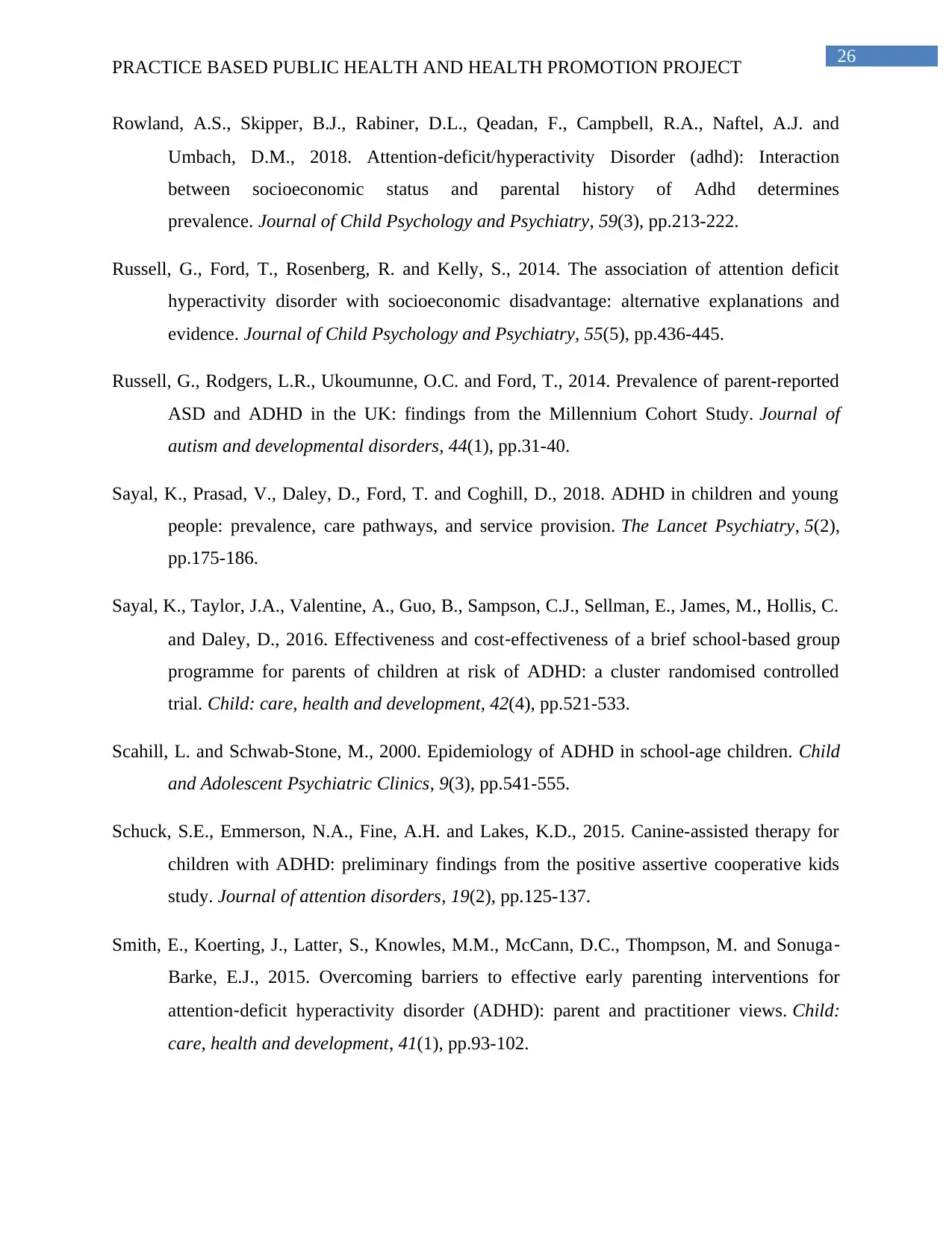
26
PRACTICE BASED PUBLIC HEALTH AND HEALTH PROMOTION PROJECT
Rowland, A.S., Skipper, B.J., Rabiner, D.L., Qeadan, F., Campbell, R.A., Naftel, A.J. and
Umbach, D.M., 2018. Attention‐deficit/hyperactivity Disorder (adhd): Interaction
between socioeconomic status and parental history of Adhd determines
prevalence. Journal of Child Psychology and Psychiatry, 59(3), pp.213-222.
Russell, G., Ford, T., Rosenberg, R. and Kelly, S., 2014. The association of attention deficit
hyperactivity disorder with socioeconomic disadvantage: alternative explanations and
evidence. Journal of Child Psychology and Psychiatry, 55(5), pp.436-445.
Russell, G., Rodgers, L.R., Ukoumunne, O.C. and Ford, T., 2014. Prevalence of parent-reported
ASD and ADHD in the UK: findings from the Millennium Cohort Study. Journal of
autism and developmental disorders, 44(1), pp.31-40.
Sayal, K., Prasad, V., Daley, D., Ford, T. and Coghill, D., 2018. ADHD in children and young
people: prevalence, care pathways, and service provision. The Lancet Psychiatry, 5(2),
pp.175-186.
Sayal, K., Taylor, J.A., Valentine, A., Guo, B., Sampson, C.J., Sellman, E., James, M., Hollis, C.
and Daley, D., 2016. Effectiveness and cost‐effectiveness of a brief school‐based group
programme for parents of children at risk of ADHD: a cluster randomised controlled
trial. Child: care, health and development, 42(4), pp.521-533.
Scahill, L. and Schwab-Stone, M., 2000. Epidemiology of ADHD in school-age children. Child
and Adolescent Psychiatric Clinics, 9(3), pp.541-555.
Schuck, S.E., Emmerson, N.A., Fine, A.H. and Lakes, K.D., 2015. Canine-assisted therapy for
children with ADHD: preliminary findings from the positive assertive cooperative kids
study. Journal of attention disorders, 19(2), pp.125-137.
Smith, E., Koerting, J., Latter, S., Knowles, M.M., McCann, D.C., Thompson, M. and Sonuga‐
Barke, E.J., 2015. Overcoming barriers to effective early parenting interventions for
attention‐deficit hyperactivity disorder (ADHD): parent and practitioner views. Child:
care, health and development, 41(1), pp.93-102.
PRACTICE BASED PUBLIC HEALTH AND HEALTH PROMOTION PROJECT
Rowland, A.S., Skipper, B.J., Rabiner, D.L., Qeadan, F., Campbell, R.A., Naftel, A.J. and
Umbach, D.M., 2018. Attention‐deficit/hyperactivity Disorder (adhd): Interaction
between socioeconomic status and parental history of Adhd determines
prevalence. Journal of Child Psychology and Psychiatry, 59(3), pp.213-222.
Russell, G., Ford, T., Rosenberg, R. and Kelly, S., 2014. The association of attention deficit
hyperactivity disorder with socioeconomic disadvantage: alternative explanations and
evidence. Journal of Child Psychology and Psychiatry, 55(5), pp.436-445.
Russell, G., Rodgers, L.R., Ukoumunne, O.C. and Ford, T., 2014. Prevalence of parent-reported
ASD and ADHD in the UK: findings from the Millennium Cohort Study. Journal of
autism and developmental disorders, 44(1), pp.31-40.
Sayal, K., Prasad, V., Daley, D., Ford, T. and Coghill, D., 2018. ADHD in children and young
people: prevalence, care pathways, and service provision. The Lancet Psychiatry, 5(2),
pp.175-186.
Sayal, K., Taylor, J.A., Valentine, A., Guo, B., Sampson, C.J., Sellman, E., James, M., Hollis, C.
and Daley, D., 2016. Effectiveness and cost‐effectiveness of a brief school‐based group
programme for parents of children at risk of ADHD: a cluster randomised controlled
trial. Child: care, health and development, 42(4), pp.521-533.
Scahill, L. and Schwab-Stone, M., 2000. Epidemiology of ADHD in school-age children. Child
and Adolescent Psychiatric Clinics, 9(3), pp.541-555.
Schuck, S.E., Emmerson, N.A., Fine, A.H. and Lakes, K.D., 2015. Canine-assisted therapy for
children with ADHD: preliminary findings from the positive assertive cooperative kids
study. Journal of attention disorders, 19(2), pp.125-137.
Smith, E., Koerting, J., Latter, S., Knowles, M.M., McCann, D.C., Thompson, M. and Sonuga‐
Barke, E.J., 2015. Overcoming barriers to effective early parenting interventions for
attention‐deficit hyperactivity disorder (ADHD): parent and practitioner views. Child:
care, health and development, 41(1), pp.93-102.
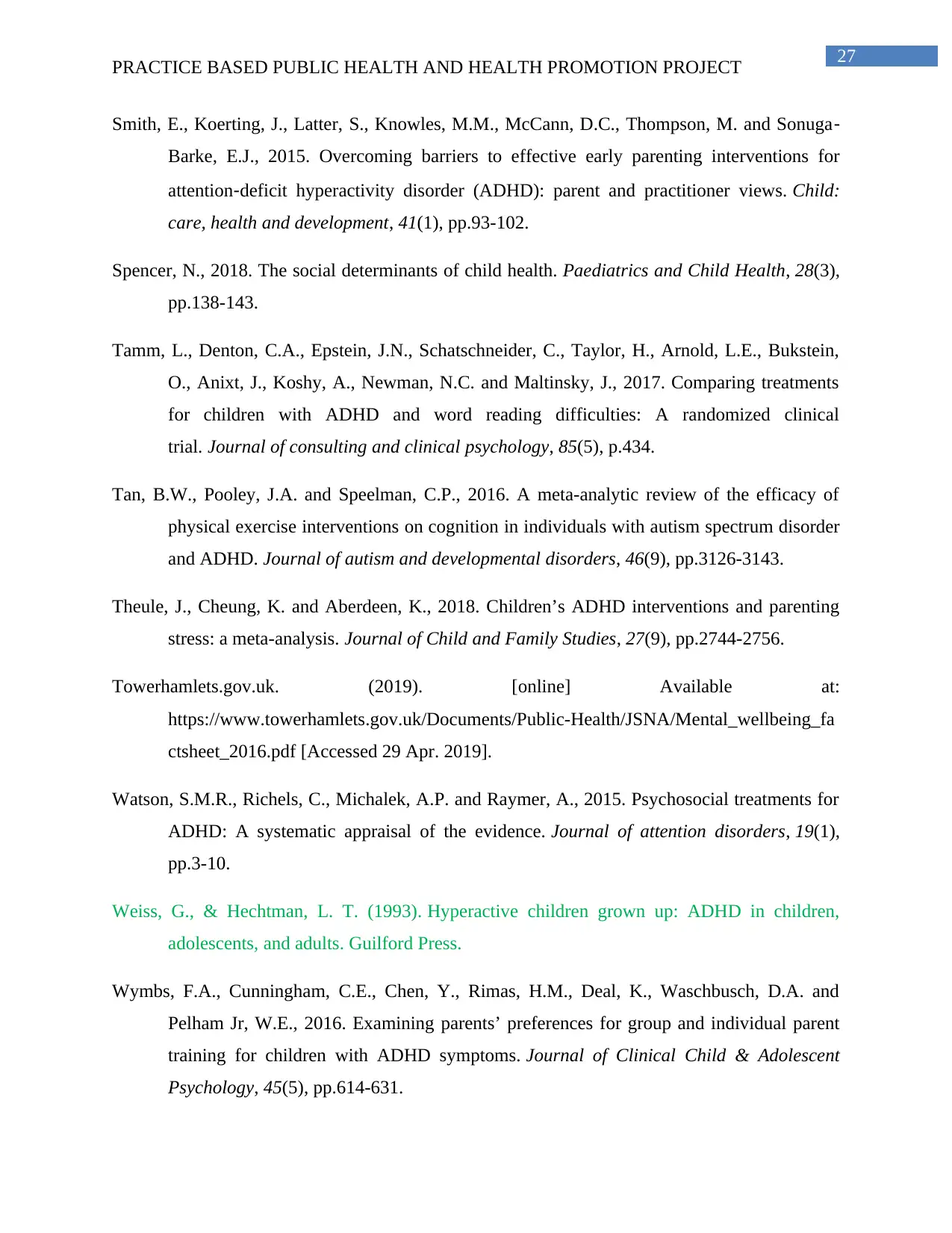
27
PRACTICE BASED PUBLIC HEALTH AND HEALTH PROMOTION PROJECT
Smith, E., Koerting, J., Latter, S., Knowles, M.M., McCann, D.C., Thompson, M. and Sonuga‐
Barke, E.J., 2015. Overcoming barriers to effective early parenting interventions for
attention‐deficit hyperactivity disorder (ADHD): parent and practitioner views. Child:
care, health and development, 41(1), pp.93-102.
Spencer, N., 2018. The social determinants of child health. Paediatrics and Child Health, 28(3),
pp.138-143.
Tamm, L., Denton, C.A., Epstein, J.N., Schatschneider, C., Taylor, H., Arnold, L.E., Bukstein,
O., Anixt, J., Koshy, A., Newman, N.C. and Maltinsky, J., 2017. Comparing treatments
for children with ADHD and word reading difficulties: A randomized clinical
trial. Journal of consulting and clinical psychology, 85(5), p.434.
Tan, B.W., Pooley, J.A. and Speelman, C.P., 2016. A meta-analytic review of the efficacy of
physical exercise interventions on cognition in individuals with autism spectrum disorder
and ADHD. Journal of autism and developmental disorders, 46(9), pp.3126-3143.
Theule, J., Cheung, K. and Aberdeen, K., 2018. Children’s ADHD interventions and parenting
stress: a meta-analysis. Journal of Child and Family Studies, 27(9), pp.2744-2756.
Towerhamlets.gov.uk. (2019). [online] Available at:
https://www.towerhamlets.gov.uk/Documents/Public-Health/JSNA/Mental_wellbeing_fa
ctsheet_2016.pdf [Accessed 29 Apr. 2019].
Watson, S.M.R., Richels, C., Michalek, A.P. and Raymer, A., 2015. Psychosocial treatments for
ADHD: A systematic appraisal of the evidence. Journal of attention disorders, 19(1),
pp.3-10.
Weiss, G., & Hechtman, L. T. (1993). Hyperactive children grown up: ADHD in children,
adolescents, and adults. Guilford Press.
Wymbs, F.A., Cunningham, C.E., Chen, Y., Rimas, H.M., Deal, K., Waschbusch, D.A. and
Pelham Jr, W.E., 2016. Examining parents’ preferences for group and individual parent
training for children with ADHD symptoms. Journal of Clinical Child & Adolescent
Psychology, 45(5), pp.614-631.
PRACTICE BASED PUBLIC HEALTH AND HEALTH PROMOTION PROJECT
Smith, E., Koerting, J., Latter, S., Knowles, M.M., McCann, D.C., Thompson, M. and Sonuga‐
Barke, E.J., 2015. Overcoming barriers to effective early parenting interventions for
attention‐deficit hyperactivity disorder (ADHD): parent and practitioner views. Child:
care, health and development, 41(1), pp.93-102.
Spencer, N., 2018. The social determinants of child health. Paediatrics and Child Health, 28(3),
pp.138-143.
Tamm, L., Denton, C.A., Epstein, J.N., Schatschneider, C., Taylor, H., Arnold, L.E., Bukstein,
O., Anixt, J., Koshy, A., Newman, N.C. and Maltinsky, J., 2017. Comparing treatments
for children with ADHD and word reading difficulties: A randomized clinical
trial. Journal of consulting and clinical psychology, 85(5), p.434.
Tan, B.W., Pooley, J.A. and Speelman, C.P., 2016. A meta-analytic review of the efficacy of
physical exercise interventions on cognition in individuals with autism spectrum disorder
and ADHD. Journal of autism and developmental disorders, 46(9), pp.3126-3143.
Theule, J., Cheung, K. and Aberdeen, K., 2018. Children’s ADHD interventions and parenting
stress: a meta-analysis. Journal of Child and Family Studies, 27(9), pp.2744-2756.
Towerhamlets.gov.uk. (2019). [online] Available at:
https://www.towerhamlets.gov.uk/Documents/Public-Health/JSNA/Mental_wellbeing_fa
ctsheet_2016.pdf [Accessed 29 Apr. 2019].
Watson, S.M.R., Richels, C., Michalek, A.P. and Raymer, A., 2015. Psychosocial treatments for
ADHD: A systematic appraisal of the evidence. Journal of attention disorders, 19(1),
pp.3-10.
Weiss, G., & Hechtman, L. T. (1993). Hyperactive children grown up: ADHD in children,
adolescents, and adults. Guilford Press.
Wymbs, F.A., Cunningham, C.E., Chen, Y., Rimas, H.M., Deal, K., Waschbusch, D.A. and
Pelham Jr, W.E., 2016. Examining parents’ preferences for group and individual parent
training for children with ADHD symptoms. Journal of Clinical Child & Adolescent
Psychology, 45(5), pp.614-631.
Paraphrase This Document
Need a fresh take? Get an instant paraphrase of this document with our AI Paraphraser

28
PRACTICE BASED PUBLIC HEALTH AND HEALTH PROMOTION PROJECT
PRACTICE BASED PUBLIC HEALTH AND HEALTH PROMOTION PROJECT
1 out of 29
![[object Object]](/_next/static/media/star-bottom.7253800d.svg)





